Health Assessment Techniques and Adolescent Development
VerifiedAdded on 2021/04/21
|22
|4412
|30
AI Summary
The provided assignment details the various stages of human development from early adolescence to older adulthood, highlighting major activities and health needs at each stage. It also includes a problem-solving approach to any solution, methods used to measure or evaluate vision and hearing, aids and equipment for assisting clients with vision and/or hearing impairment, and common health issues in adolescents such as physical changes, emotional changes, behavioral variations, and substance abuse and use.
Contribute Materials
Your contribution can guide someone’s learning journey. Share your
documents today.

Running head: THEORY ASSESSMENT 1
THEORY ASSESSMENT
Student’s Name
Institution Affiliation
Course
Date
THEORY ASSESSMENT
Student’s Name
Institution Affiliation
Course
Date
Secure Best Marks with AI Grader
Need help grading? Try our AI Grader for instant feedback on your assignments.
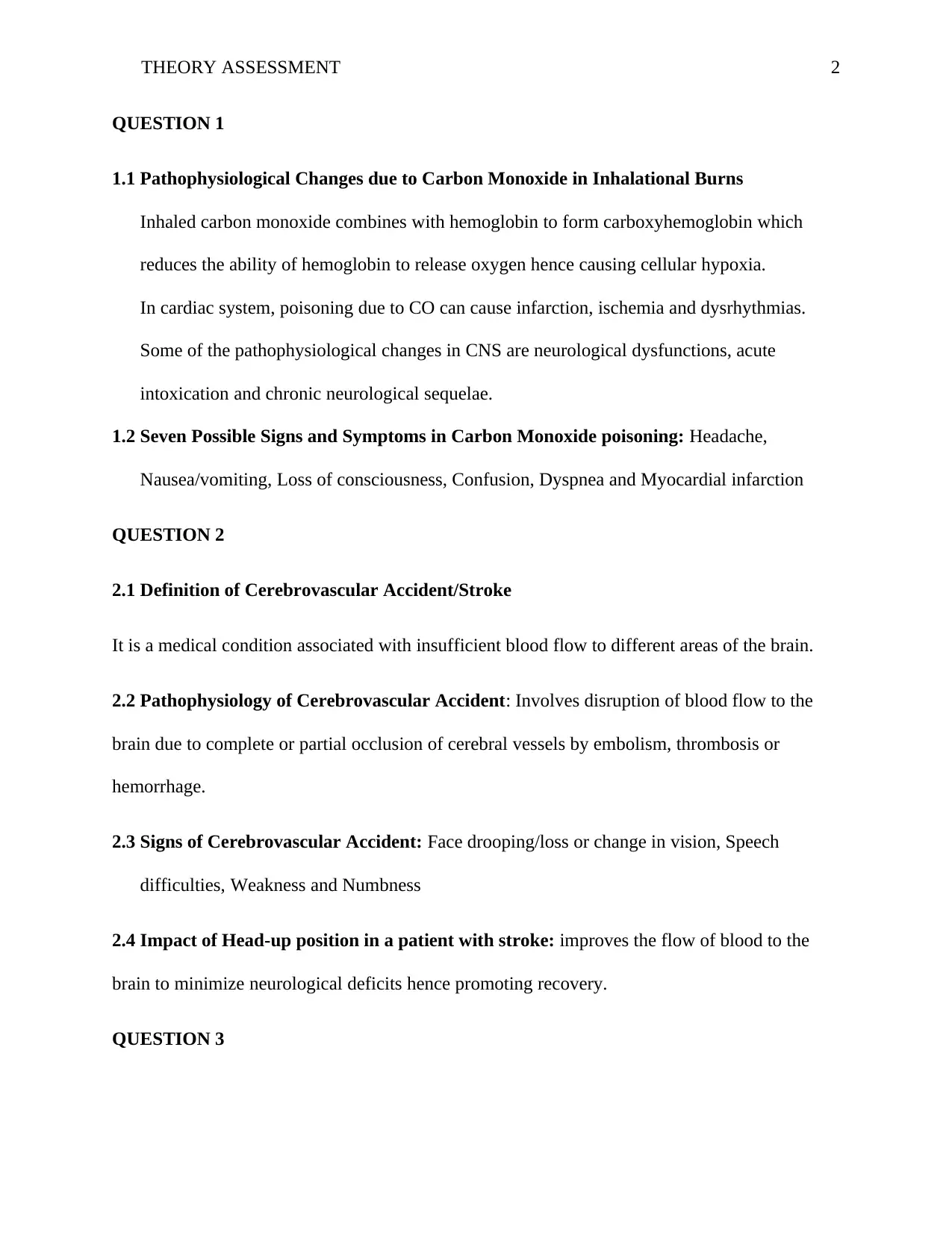
THEORY ASSESSMENT 2
QUESTION 1
1.1 Pathophysiological Changes due to Carbon Monoxide in Inhalational Burns
Inhaled carbon monoxide combines with hemoglobin to form carboxyhemoglobin which
reduces the ability of hemoglobin to release oxygen hence causing cellular hypoxia.
In cardiac system, poisoning due to CO can cause infarction, ischemia and dysrhythmias.
Some of the pathophysiological changes in CNS are neurological dysfunctions, acute
intoxication and chronic neurological sequelae.
1.2 Seven Possible Signs and Symptoms in Carbon Monoxide poisoning: Headache,
Nausea/vomiting, Loss of consciousness, Confusion, Dyspnea and Myocardial infarction
QUESTION 2
2.1 Definition of Cerebrovascular Accident/Stroke
It is a medical condition associated with insufficient blood flow to different areas of the brain.
2.2 Pathophysiology of Cerebrovascular Accident: Involves disruption of blood flow to the
brain due to complete or partial occlusion of cerebral vessels by embolism, thrombosis or
hemorrhage.
2.3 Signs of Cerebrovascular Accident: Face drooping/loss or change in vision, Speech
difficulties, Weakness and Numbness
2.4 Impact of Head-up position in a patient with stroke: improves the flow of blood to the
brain to minimize neurological deficits hence promoting recovery.
QUESTION 3
QUESTION 1
1.1 Pathophysiological Changes due to Carbon Monoxide in Inhalational Burns
Inhaled carbon monoxide combines with hemoglobin to form carboxyhemoglobin which
reduces the ability of hemoglobin to release oxygen hence causing cellular hypoxia.
In cardiac system, poisoning due to CO can cause infarction, ischemia and dysrhythmias.
Some of the pathophysiological changes in CNS are neurological dysfunctions, acute
intoxication and chronic neurological sequelae.
1.2 Seven Possible Signs and Symptoms in Carbon Monoxide poisoning: Headache,
Nausea/vomiting, Loss of consciousness, Confusion, Dyspnea and Myocardial infarction
QUESTION 2
2.1 Definition of Cerebrovascular Accident/Stroke
It is a medical condition associated with insufficient blood flow to different areas of the brain.
2.2 Pathophysiology of Cerebrovascular Accident: Involves disruption of blood flow to the
brain due to complete or partial occlusion of cerebral vessels by embolism, thrombosis or
hemorrhage.
2.3 Signs of Cerebrovascular Accident: Face drooping/loss or change in vision, Speech
difficulties, Weakness and Numbness
2.4 Impact of Head-up position in a patient with stroke: improves the flow of blood to the
brain to minimize neurological deficits hence promoting recovery.
QUESTION 3
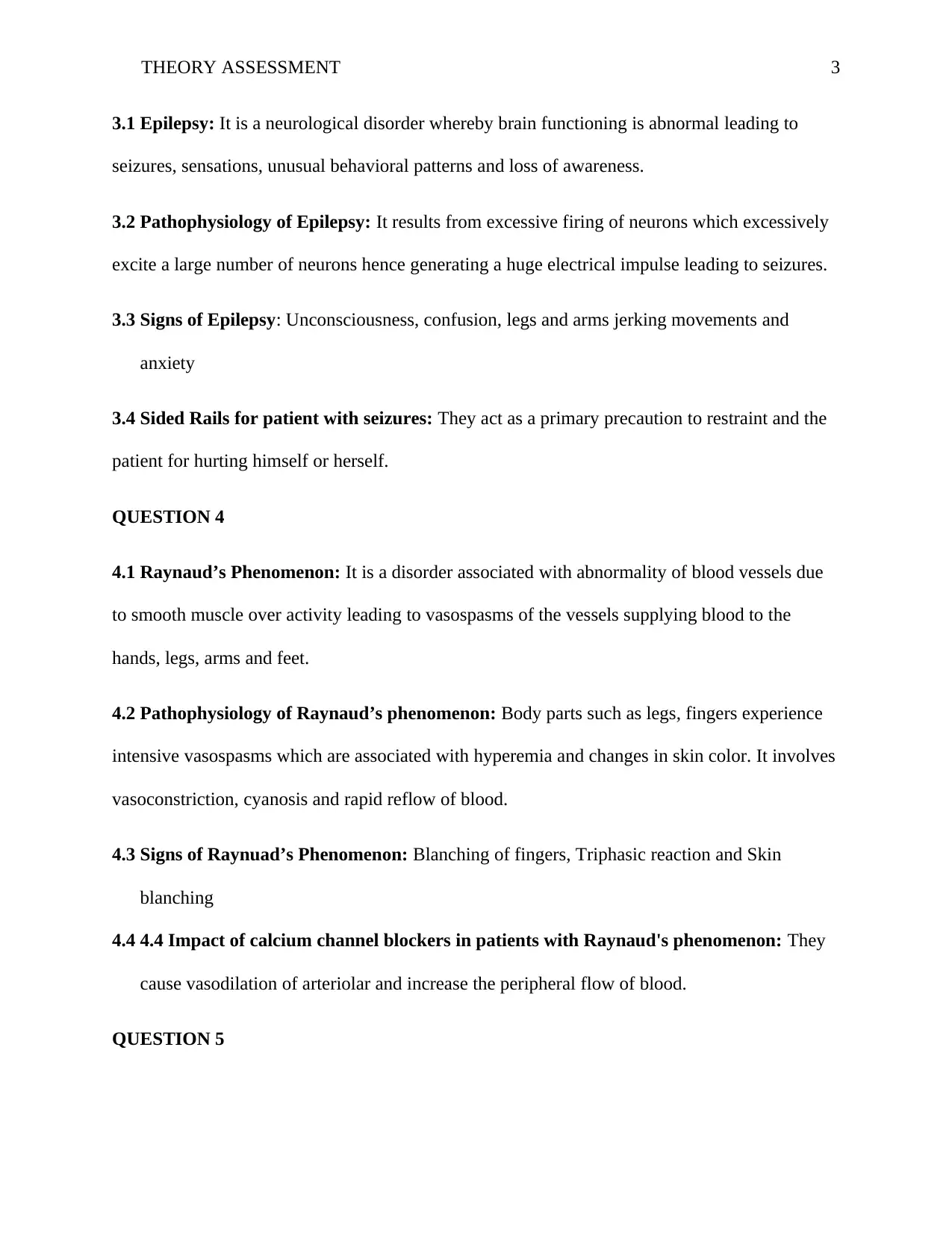
THEORY ASSESSMENT 3
3.1 Epilepsy: It is a neurological disorder whereby brain functioning is abnormal leading to
seizures, sensations, unusual behavioral patterns and loss of awareness.
3.2 Pathophysiology of Epilepsy: It results from excessive firing of neurons which excessively
excite a large number of neurons hence generating a huge electrical impulse leading to seizures.
3.3 Signs of Epilepsy: Unconsciousness, confusion, legs and arms jerking movements and
anxiety
3.4 Sided Rails for patient with seizures: They act as a primary precaution to restraint and the
patient for hurting himself or herself.
QUESTION 4
4.1 Raynaud’s Phenomenon: It is a disorder associated with abnormality of blood vessels due
to smooth muscle over activity leading to vasospasms of the vessels supplying blood to the
hands, legs, arms and feet.
4.2 Pathophysiology of Raynaud’s phenomenon: Body parts such as legs, fingers experience
intensive vasospasms which are associated with hyperemia and changes in skin color. It involves
vasoconstriction, cyanosis and rapid reflow of blood.
4.3 Signs of Raynuad’s Phenomenon: Blanching of fingers, Triphasic reaction and Skin
blanching
4.4 4.4 Impact of calcium channel blockers in patients with Raynaud's phenomenon: They
cause vasodilation of arteriolar and increase the peripheral flow of blood.
QUESTION 5
3.1 Epilepsy: It is a neurological disorder whereby brain functioning is abnormal leading to
seizures, sensations, unusual behavioral patterns and loss of awareness.
3.2 Pathophysiology of Epilepsy: It results from excessive firing of neurons which excessively
excite a large number of neurons hence generating a huge electrical impulse leading to seizures.
3.3 Signs of Epilepsy: Unconsciousness, confusion, legs and arms jerking movements and
anxiety
3.4 Sided Rails for patient with seizures: They act as a primary precaution to restraint and the
patient for hurting himself or herself.
QUESTION 4
4.1 Raynaud’s Phenomenon: It is a disorder associated with abnormality of blood vessels due
to smooth muscle over activity leading to vasospasms of the vessels supplying blood to the
hands, legs, arms and feet.
4.2 Pathophysiology of Raynaud’s phenomenon: Body parts such as legs, fingers experience
intensive vasospasms which are associated with hyperemia and changes in skin color. It involves
vasoconstriction, cyanosis and rapid reflow of blood.
4.3 Signs of Raynuad’s Phenomenon: Blanching of fingers, Triphasic reaction and Skin
blanching
4.4 4.4 Impact of calcium channel blockers in patients with Raynaud's phenomenon: They
cause vasodilation of arteriolar and increase the peripheral flow of blood.
QUESTION 5
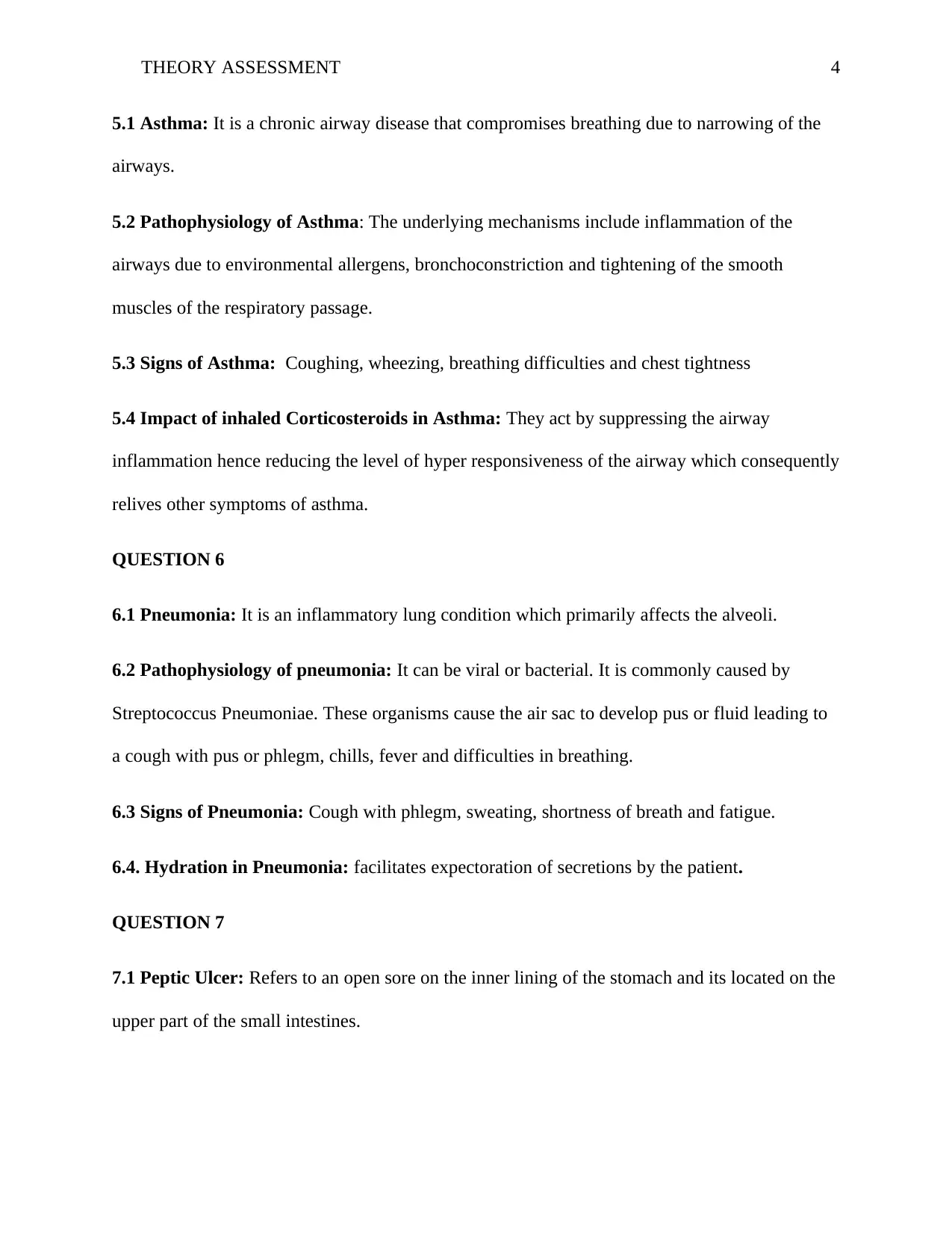
THEORY ASSESSMENT 4
5.1 Asthma: It is a chronic airway disease that compromises breathing due to narrowing of the
airways.
5.2 Pathophysiology of Asthma: The underlying mechanisms include inflammation of the
airways due to environmental allergens, bronchoconstriction and tightening of the smooth
muscles of the respiratory passage.
5.3 Signs of Asthma: Coughing, wheezing, breathing difficulties and chest tightness
5.4 Impact of inhaled Corticosteroids in Asthma: They act by suppressing the airway
inflammation hence reducing the level of hyper responsiveness of the airway which consequently
relives other symptoms of asthma.
QUESTION 6
6.1 Pneumonia: It is an inflammatory lung condition which primarily affects the alveoli.
6.2 Pathophysiology of pneumonia: It can be viral or bacterial. It is commonly caused by
Streptococcus Pneumoniae. These organisms cause the air sac to develop pus or fluid leading to
a cough with pus or phlegm, chills, fever and difficulties in breathing.
6.3 Signs of Pneumonia: Cough with phlegm, sweating, shortness of breath and fatigue.
6.4. Hydration in Pneumonia: facilitates expectoration of secretions by the patient.
QUESTION 7
7.1 Peptic Ulcer: Refers to an open sore on the inner lining of the stomach and its located on the
upper part of the small intestines.
5.1 Asthma: It is a chronic airway disease that compromises breathing due to narrowing of the
airways.
5.2 Pathophysiology of Asthma: The underlying mechanisms include inflammation of the
airways due to environmental allergens, bronchoconstriction and tightening of the smooth
muscles of the respiratory passage.
5.3 Signs of Asthma: Coughing, wheezing, breathing difficulties and chest tightness
5.4 Impact of inhaled Corticosteroids in Asthma: They act by suppressing the airway
inflammation hence reducing the level of hyper responsiveness of the airway which consequently
relives other symptoms of asthma.
QUESTION 6
6.1 Pneumonia: It is an inflammatory lung condition which primarily affects the alveoli.
6.2 Pathophysiology of pneumonia: It can be viral or bacterial. It is commonly caused by
Streptococcus Pneumoniae. These organisms cause the air sac to develop pus or fluid leading to
a cough with pus or phlegm, chills, fever and difficulties in breathing.
6.3 Signs of Pneumonia: Cough with phlegm, sweating, shortness of breath and fatigue.
6.4. Hydration in Pneumonia: facilitates expectoration of secretions by the patient.
QUESTION 7
7.1 Peptic Ulcer: Refers to an open sore on the inner lining of the stomach and its located on the
upper part of the small intestines.
Secure Best Marks with AI Grader
Need help grading? Try our AI Grader for instant feedback on your assignments.

THEORY ASSESSMENT 5
7.2 Pathophysiology of peptic ulcer: Mucosal injury due to disruption in protective and
aggressive factors. Protective factors include epithelial renewal, bicarbonate, sufficient mucosal
blood flow and prostaglandins while aggressive factors are infection due to Pylori, alcohol
consumption, NSAIDS, pepsin and bile salts.
7.3 Signs of peptic ulcer: Abdominal pain between the bottom of the belly and breastbone,
increased level of indigestion, nausea and heavy abdomen.
7.4 Impact of antibiotic therapy on patients with peptic ulcer disease: Kills the H.Pylori
bacteria, suppresses production of acid and neutralize any acid in the stomach.
QUESTION 8
8.1 Cirrhosis of liver: It is a liver disease complication involving liver cell loss and irreversible
liver scarring.
8.2 Pathophysiology of cirrhosis of liver: It involves hepatocyte destruction, scarring or
fibrosis leading to obstruction of the flow of blood, high pressure in sinusoidal and venous
channels.
8.3 Signs of Cirrohsis of the liver: Anorexia, Yellow skin discoloration, easy bleeding and leg
swelling.
8.4 impact of a high protein diet on patients with Cirrhosis of the Liver: Improves and
supports liver functioning hence promoting healing.
QUESTION 9
9.1 GOUT: An inflammatory arthritis associated with recurring attacks of hot, red, swollen
joints.
7.2 Pathophysiology of peptic ulcer: Mucosal injury due to disruption in protective and
aggressive factors. Protective factors include epithelial renewal, bicarbonate, sufficient mucosal
blood flow and prostaglandins while aggressive factors are infection due to Pylori, alcohol
consumption, NSAIDS, pepsin and bile salts.
7.3 Signs of peptic ulcer: Abdominal pain between the bottom of the belly and breastbone,
increased level of indigestion, nausea and heavy abdomen.
7.4 Impact of antibiotic therapy on patients with peptic ulcer disease: Kills the H.Pylori
bacteria, suppresses production of acid and neutralize any acid in the stomach.
QUESTION 8
8.1 Cirrhosis of liver: It is a liver disease complication involving liver cell loss and irreversible
liver scarring.
8.2 Pathophysiology of cirrhosis of liver: It involves hepatocyte destruction, scarring or
fibrosis leading to obstruction of the flow of blood, high pressure in sinusoidal and venous
channels.
8.3 Signs of Cirrohsis of the liver: Anorexia, Yellow skin discoloration, easy bleeding and leg
swelling.
8.4 impact of a high protein diet on patients with Cirrhosis of the Liver: Improves and
supports liver functioning hence promoting healing.
QUESTION 9
9.1 GOUT: An inflammatory arthritis associated with recurring attacks of hot, red, swollen
joints.
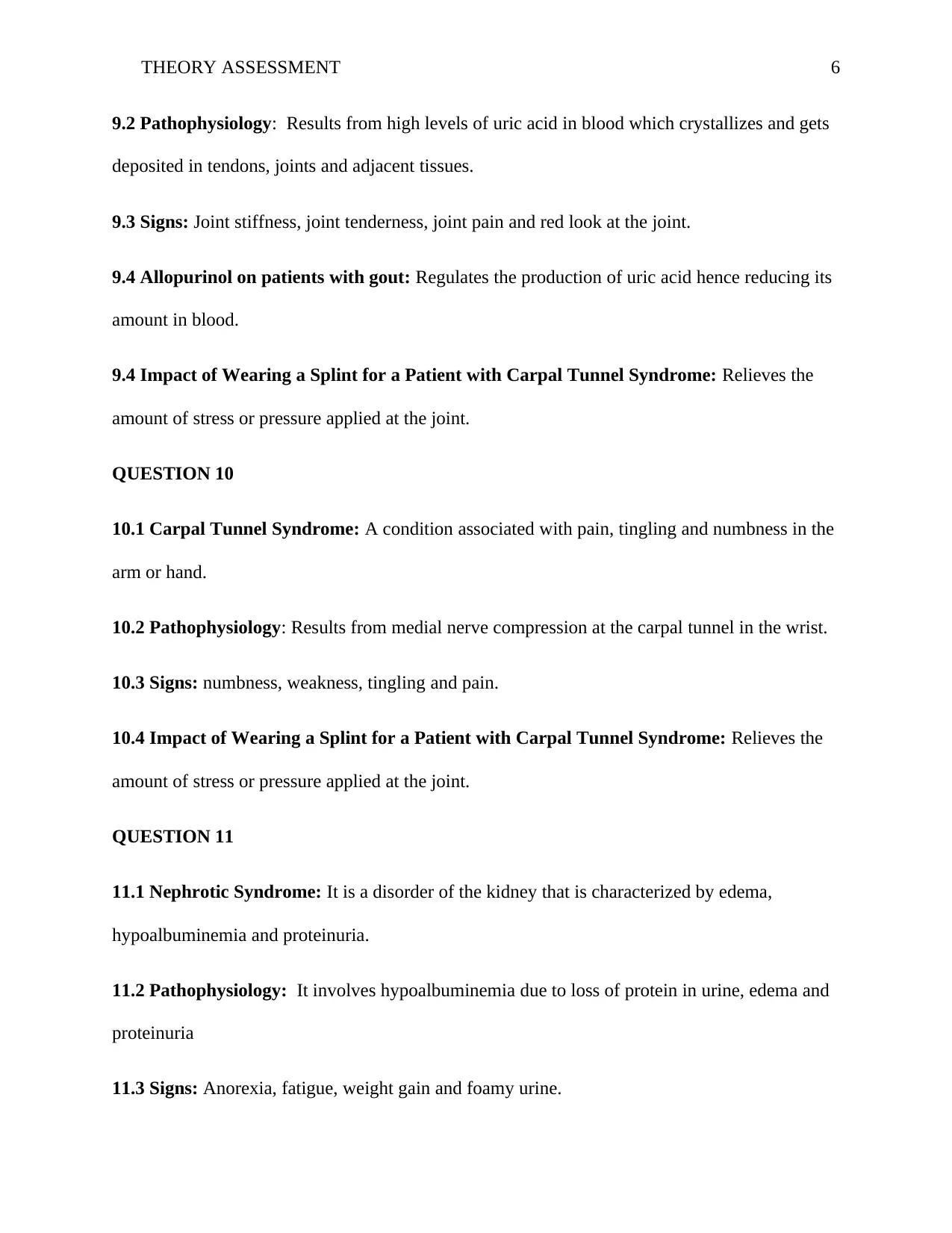
THEORY ASSESSMENT 6
9.2 Pathophysiology: Results from high levels of uric acid in blood which crystallizes and gets
deposited in tendons, joints and adjacent tissues.
9.3 Signs: Joint stiffness, joint tenderness, joint pain and red look at the joint.
9.4 Allopurinol on patients with gout: Regulates the production of uric acid hence reducing its
amount in blood.
9.4 Impact of Wearing a Splint for a Patient with Carpal Tunnel Syndrome: Relieves the
amount of stress or pressure applied at the joint.
QUESTION 10
10.1 Carpal Tunnel Syndrome: A condition associated with pain, tingling and numbness in the
arm or hand.
10.2 Pathophysiology: Results from medial nerve compression at the carpal tunnel in the wrist.
10.3 Signs: numbness, weakness, tingling and pain.
10.4 Impact of Wearing a Splint for a Patient with Carpal Tunnel Syndrome: Relieves the
amount of stress or pressure applied at the joint.
QUESTION 11
11.1 Nephrotic Syndrome: It is a disorder of the kidney that is characterized by edema,
hypoalbuminemia and proteinuria.
11.2 Pathophysiology: It involves hypoalbuminemia due to loss of protein in urine, edema and
proteinuria
11.3 Signs: Anorexia, fatigue, weight gain and foamy urine.
9.2 Pathophysiology: Results from high levels of uric acid in blood which crystallizes and gets
deposited in tendons, joints and adjacent tissues.
9.3 Signs: Joint stiffness, joint tenderness, joint pain and red look at the joint.
9.4 Allopurinol on patients with gout: Regulates the production of uric acid hence reducing its
amount in blood.
9.4 Impact of Wearing a Splint for a Patient with Carpal Tunnel Syndrome: Relieves the
amount of stress or pressure applied at the joint.
QUESTION 10
10.1 Carpal Tunnel Syndrome: A condition associated with pain, tingling and numbness in the
arm or hand.
10.2 Pathophysiology: Results from medial nerve compression at the carpal tunnel in the wrist.
10.3 Signs: numbness, weakness, tingling and pain.
10.4 Impact of Wearing a Splint for a Patient with Carpal Tunnel Syndrome: Relieves the
amount of stress or pressure applied at the joint.
QUESTION 11
11.1 Nephrotic Syndrome: It is a disorder of the kidney that is characterized by edema,
hypoalbuminemia and proteinuria.
11.2 Pathophysiology: It involves hypoalbuminemia due to loss of protein in urine, edema and
proteinuria
11.3 Signs: Anorexia, fatigue, weight gain and foamy urine.

THEORY ASSESSMENT 7
11.4 Restriction of Salt intake in nephrotic syndrome: It helps to avoid fluid and electrolyte
imbalances which could severely damage the kidneys.
QUESTION 12
12.1 Urinary Tract Infection (UTI): An infection the kidneys, bladder, ureters or urethra of the
urinary system.
12.2 Pathophysiology: They are caused by microorganisms such as bacterial, viruses and fungi
in the upper and lower urinary tract.
12.3 Signs: Pain, tenderness, bloody urine, burning sensation during urination
12.4 Fluid intake in UTI: Promotes kidney functioning and prevents formation of concentrated
urine which might cause irritation of the urinary bladder leading to a high risks of UTI
development.
QUESTION 13
13.1 Prostatic Cancer: Non-cutaneous Cancer of the prostate gland in men.
13.2 Pathophysiology: Uncontrollable and excessive growth of prostate cells leading to a
malignancy at the prostate gland.
13.3 Signs: hematuria, painful and difficult urination, reduced bladder control and reduced urine
velocity
13.4 Impact of 5 alpha reductase inhibitors on patients with prostatic cancer: They prevent
conversion of sex hormone testosterone to dihydrotestosterone (DHT) which is more potent
androgen. They prevent this conversion by blocking the action of 5 alpha reductase which
facilitates conversion of testosterone hormone to DHT hence decreasing DHT levels and
11.4 Restriction of Salt intake in nephrotic syndrome: It helps to avoid fluid and electrolyte
imbalances which could severely damage the kidneys.
QUESTION 12
12.1 Urinary Tract Infection (UTI): An infection the kidneys, bladder, ureters or urethra of the
urinary system.
12.2 Pathophysiology: They are caused by microorganisms such as bacterial, viruses and fungi
in the upper and lower urinary tract.
12.3 Signs: Pain, tenderness, bloody urine, burning sensation during urination
12.4 Fluid intake in UTI: Promotes kidney functioning and prevents formation of concentrated
urine which might cause irritation of the urinary bladder leading to a high risks of UTI
development.
QUESTION 13
13.1 Prostatic Cancer: Non-cutaneous Cancer of the prostate gland in men.
13.2 Pathophysiology: Uncontrollable and excessive growth of prostate cells leading to a
malignancy at the prostate gland.
13.3 Signs: hematuria, painful and difficult urination, reduced bladder control and reduced urine
velocity
13.4 Impact of 5 alpha reductase inhibitors on patients with prostatic cancer: They prevent
conversion of sex hormone testosterone to dihydrotestosterone (DHT) which is more potent
androgen. They prevent this conversion by blocking the action of 5 alpha reductase which
facilitates conversion of testosterone hormone to DHT hence decreasing DHT levels and
Paraphrase This Document
Need a fresh take? Get an instant paraphrase of this document with our AI Paraphraser
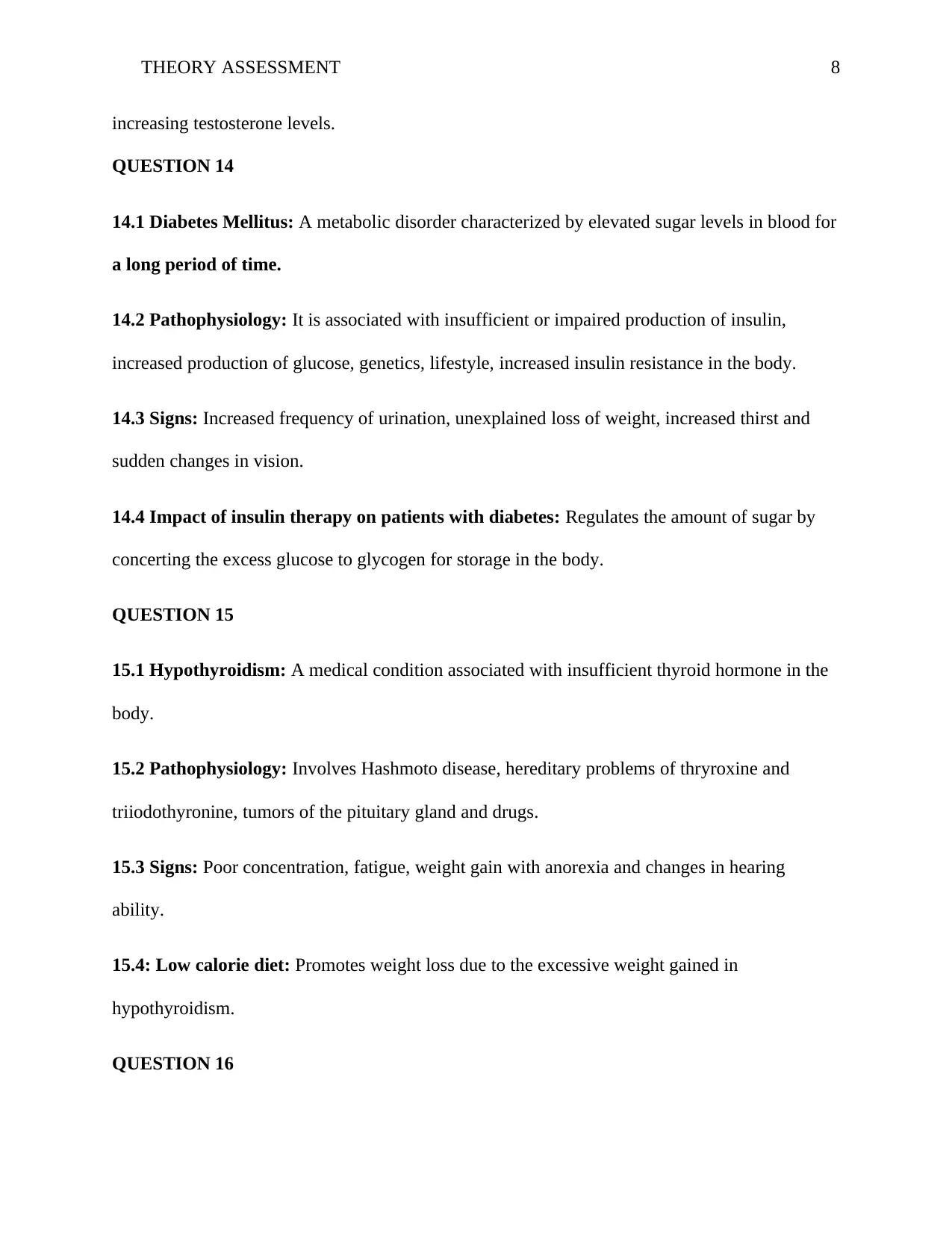
THEORY ASSESSMENT 8
increasing testosterone levels.
QUESTION 14
14.1 Diabetes Mellitus: A metabolic disorder characterized by elevated sugar levels in blood for
a long period of time.
14.2 Pathophysiology: It is associated with insufficient or impaired production of insulin,
increased production of glucose, genetics, lifestyle, increased insulin resistance in the body.
14.3 Signs: Increased frequency of urination, unexplained loss of weight, increased thirst and
sudden changes in vision.
14.4 Impact of insulin therapy on patients with diabetes: Regulates the amount of sugar by
concerting the excess glucose to glycogen for storage in the body.
QUESTION 15
15.1 Hypothyroidism: A medical condition associated with insufficient thyroid hormone in the
body.
15.2 Pathophysiology: Involves Hashmoto disease, hereditary problems of thryroxine and
triiodothyronine, tumors of the pituitary gland and drugs.
15.3 Signs: Poor concentration, fatigue, weight gain with anorexia and changes in hearing
ability.
15.4: Low calorie diet: Promotes weight loss due to the excessive weight gained in
hypothyroidism.
QUESTION 16
increasing testosterone levels.
QUESTION 14
14.1 Diabetes Mellitus: A metabolic disorder characterized by elevated sugar levels in blood for
a long period of time.
14.2 Pathophysiology: It is associated with insufficient or impaired production of insulin,
increased production of glucose, genetics, lifestyle, increased insulin resistance in the body.
14.3 Signs: Increased frequency of urination, unexplained loss of weight, increased thirst and
sudden changes in vision.
14.4 Impact of insulin therapy on patients with diabetes: Regulates the amount of sugar by
concerting the excess glucose to glycogen for storage in the body.
QUESTION 15
15.1 Hypothyroidism: A medical condition associated with insufficient thyroid hormone in the
body.
15.2 Pathophysiology: Involves Hashmoto disease, hereditary problems of thryroxine and
triiodothyronine, tumors of the pituitary gland and drugs.
15.3 Signs: Poor concentration, fatigue, weight gain with anorexia and changes in hearing
ability.
15.4: Low calorie diet: Promotes weight loss due to the excessive weight gained in
hypothyroidism.
QUESTION 16
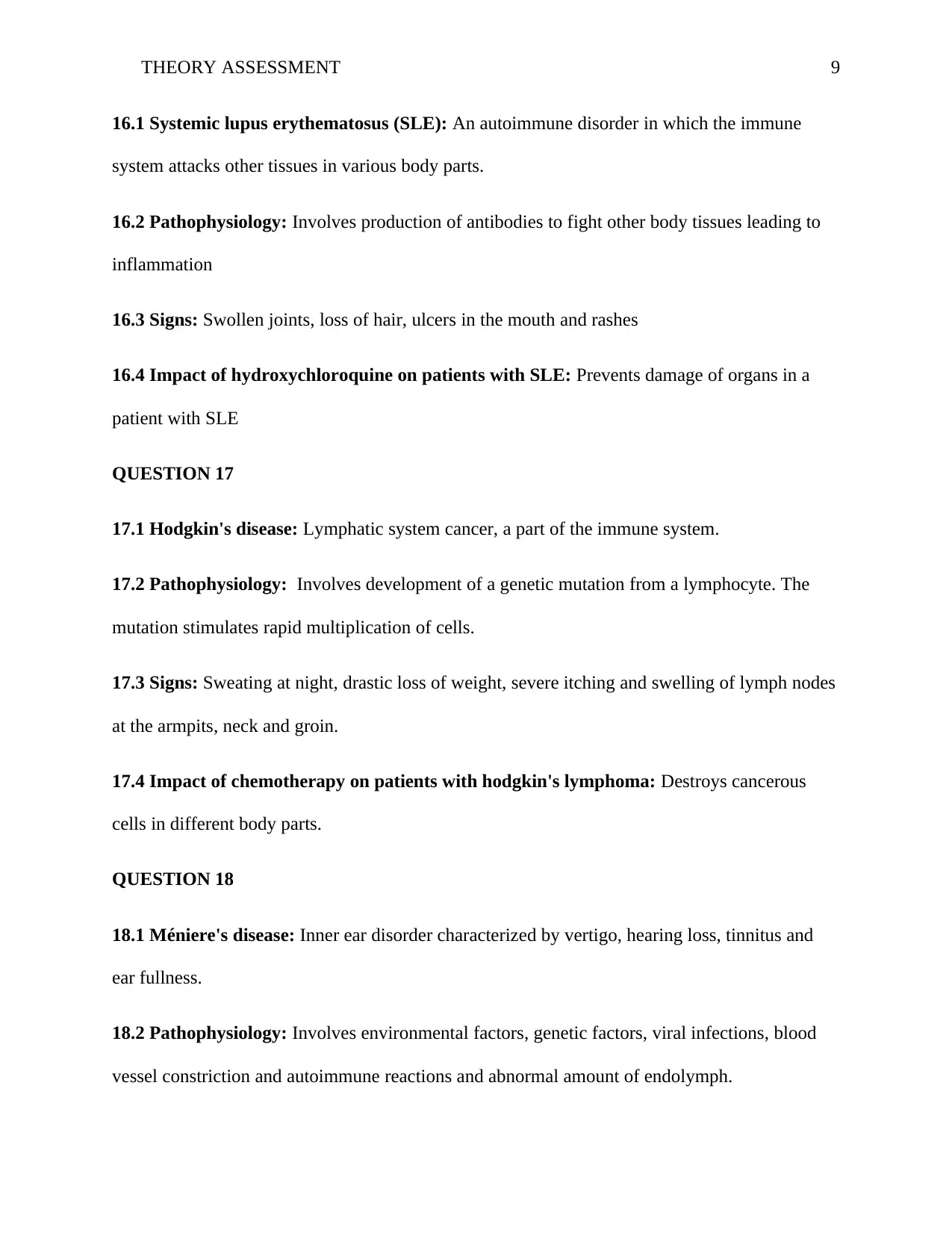
THEORY ASSESSMENT 9
16.1 Systemic lupus erythematosus (SLE): An autoimmune disorder in which the immune
system attacks other tissues in various body parts.
16.2 Pathophysiology: Involves production of antibodies to fight other body tissues leading to
inflammation
16.3 Signs: Swollen joints, loss of hair, ulcers in the mouth and rashes
16.4 Impact of hydroxychloroquine on patients with SLE: Prevents damage of organs in a
patient with SLE
QUESTION 17
17.1 Hodgkin's disease: Lymphatic system cancer, a part of the immune system.
17.2 Pathophysiology: Involves development of a genetic mutation from a lymphocyte. The
mutation stimulates rapid multiplication of cells.
17.3 Signs: Sweating at night, drastic loss of weight, severe itching and swelling of lymph nodes
at the armpits, neck and groin.
17.4 Impact of chemotherapy on patients with hodgkin's lymphoma: Destroys cancerous
cells in different body parts.
QUESTION 18
18.1 Méniere's disease: Inner ear disorder characterized by vertigo, hearing loss, tinnitus and
ear fullness.
18.2 Pathophysiology: Involves environmental factors, genetic factors, viral infections, blood
vessel constriction and autoimmune reactions and abnormal amount of endolymph.
16.1 Systemic lupus erythematosus (SLE): An autoimmune disorder in which the immune
system attacks other tissues in various body parts.
16.2 Pathophysiology: Involves production of antibodies to fight other body tissues leading to
inflammation
16.3 Signs: Swollen joints, loss of hair, ulcers in the mouth and rashes
16.4 Impact of hydroxychloroquine on patients with SLE: Prevents damage of organs in a
patient with SLE
QUESTION 17
17.1 Hodgkin's disease: Lymphatic system cancer, a part of the immune system.
17.2 Pathophysiology: Involves development of a genetic mutation from a lymphocyte. The
mutation stimulates rapid multiplication of cells.
17.3 Signs: Sweating at night, drastic loss of weight, severe itching and swelling of lymph nodes
at the armpits, neck and groin.
17.4 Impact of chemotherapy on patients with hodgkin's lymphoma: Destroys cancerous
cells in different body parts.
QUESTION 18
18.1 Méniere's disease: Inner ear disorder characterized by vertigo, hearing loss, tinnitus and
ear fullness.
18.2 Pathophysiology: Involves environmental factors, genetic factors, viral infections, blood
vessel constriction and autoimmune reactions and abnormal amount of endolymph.
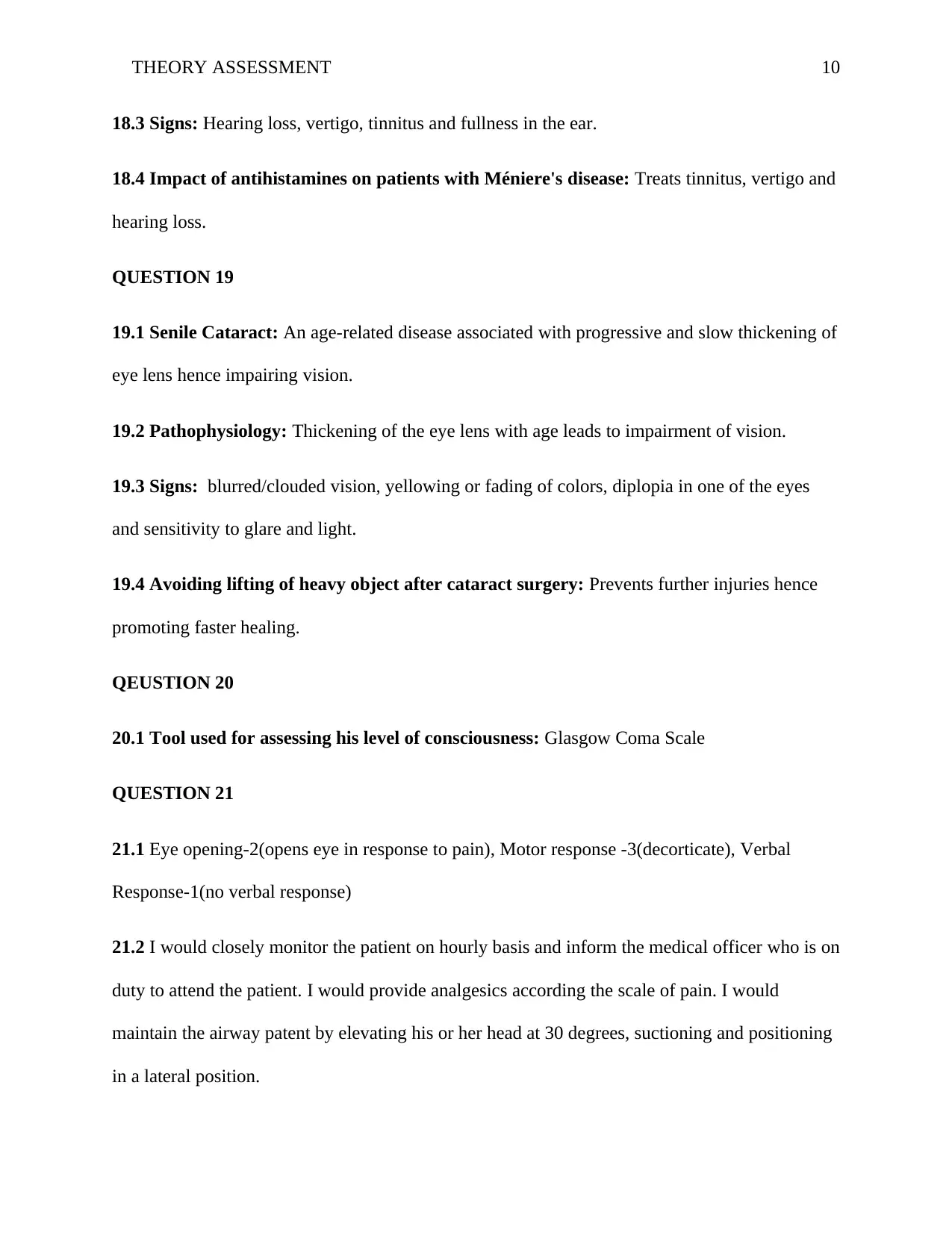
THEORY ASSESSMENT 10
18.3 Signs: Hearing loss, vertigo, tinnitus and fullness in the ear.
18.4 Impact of antihistamines on patients with Méniere's disease: Treats tinnitus, vertigo and
hearing loss.
QUESTION 19
19.1 Senile Cataract: An age-related disease associated with progressive and slow thickening of
eye lens hence impairing vision.
19.2 Pathophysiology: Thickening of the eye lens with age leads to impairment of vision.
19.3 Signs: blurred/clouded vision, yellowing or fading of colors, diplopia in one of the eyes
and sensitivity to glare and light.
19.4 Avoiding lifting of heavy object after cataract surgery: Prevents further injuries hence
promoting faster healing.
QEUSTION 20
20.1 Tool used for assessing his level of consciousness: Glasgow Coma Scale
QUESTION 21
21.1 Eye opening-2(opens eye in response to pain), Motor response -3(decorticate), Verbal
Response-1(no verbal response)
21.2 I would closely monitor the patient on hourly basis and inform the medical officer who is on
duty to attend the patient. I would provide analgesics according the scale of pain. I would
maintain the airway patent by elevating his or her head at 30 degrees, suctioning and positioning
in a lateral position.
18.3 Signs: Hearing loss, vertigo, tinnitus and fullness in the ear.
18.4 Impact of antihistamines on patients with Méniere's disease: Treats tinnitus, vertigo and
hearing loss.
QUESTION 19
19.1 Senile Cataract: An age-related disease associated with progressive and slow thickening of
eye lens hence impairing vision.
19.2 Pathophysiology: Thickening of the eye lens with age leads to impairment of vision.
19.3 Signs: blurred/clouded vision, yellowing or fading of colors, diplopia in one of the eyes
and sensitivity to glare and light.
19.4 Avoiding lifting of heavy object after cataract surgery: Prevents further injuries hence
promoting faster healing.
QEUSTION 20
20.1 Tool used for assessing his level of consciousness: Glasgow Coma Scale
QUESTION 21
21.1 Eye opening-2(opens eye in response to pain), Motor response -3(decorticate), Verbal
Response-1(no verbal response)
21.2 I would closely monitor the patient on hourly basis and inform the medical officer who is on
duty to attend the patient. I would provide analgesics according the scale of pain. I would
maintain the airway patent by elevating his or her head at 30 degrees, suctioning and positioning
in a lateral position.
Secure Best Marks with AI Grader
Need help grading? Try our AI Grader for instant feedback on your assignments.
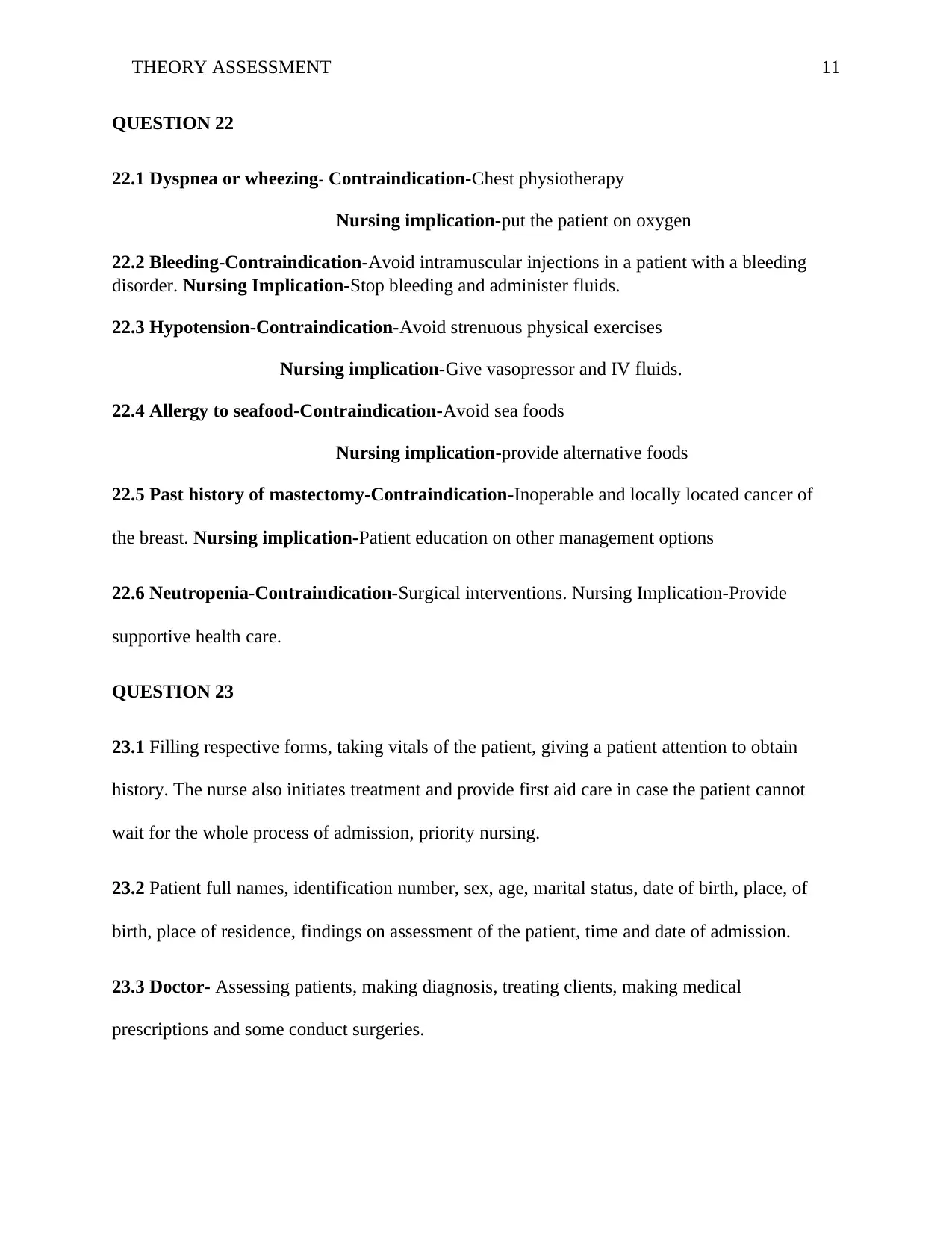
THEORY ASSESSMENT 11
QUESTION 22
22.1 Dyspnea or wheezing- Contraindication-Chest physiotherapy
Nursing implication-put the patient on oxygen
22.2 Bleeding-Contraindication-Avoid intramuscular injections in a patient with a bleeding
disorder. Nursing Implication-Stop bleeding and administer fluids.
22.3 Hypotension-Contraindication-Avoid strenuous physical exercises
Nursing implication-Give vasopressor and IV fluids.
22.4 Allergy to seafood-Contraindication-Avoid sea foods
Nursing implication-provide alternative foods
22.5 Past history of mastectomy-Contraindication-Inoperable and locally located cancer of
the breast. Nursing implication-Patient education on other management options
22.6 Neutropenia-Contraindication-Surgical interventions. Nursing Implication-Provide
supportive health care.
QUESTION 23
23.1 Filling respective forms, taking vitals of the patient, giving a patient attention to obtain
history. The nurse also initiates treatment and provide first aid care in case the patient cannot
wait for the whole process of admission, priority nursing.
23.2 Patient full names, identification number, sex, age, marital status, date of birth, place, of
birth, place of residence, findings on assessment of the patient, time and date of admission.
23.3 Doctor- Assessing patients, making diagnosis, treating clients, making medical
prescriptions and some conduct surgeries.
QUESTION 22
22.1 Dyspnea or wheezing- Contraindication-Chest physiotherapy
Nursing implication-put the patient on oxygen
22.2 Bleeding-Contraindication-Avoid intramuscular injections in a patient with a bleeding
disorder. Nursing Implication-Stop bleeding and administer fluids.
22.3 Hypotension-Contraindication-Avoid strenuous physical exercises
Nursing implication-Give vasopressor and IV fluids.
22.4 Allergy to seafood-Contraindication-Avoid sea foods
Nursing implication-provide alternative foods
22.5 Past history of mastectomy-Contraindication-Inoperable and locally located cancer of
the breast. Nursing implication-Patient education on other management options
22.6 Neutropenia-Contraindication-Surgical interventions. Nursing Implication-Provide
supportive health care.
QUESTION 23
23.1 Filling respective forms, taking vitals of the patient, giving a patient attention to obtain
history. The nurse also initiates treatment and provide first aid care in case the patient cannot
wait for the whole process of admission, priority nursing.
23.2 Patient full names, identification number, sex, age, marital status, date of birth, place, of
birth, place of residence, findings on assessment of the patient, time and date of admission.
23.3 Doctor- Assessing patients, making diagnosis, treating clients, making medical
prescriptions and some conduct surgeries.
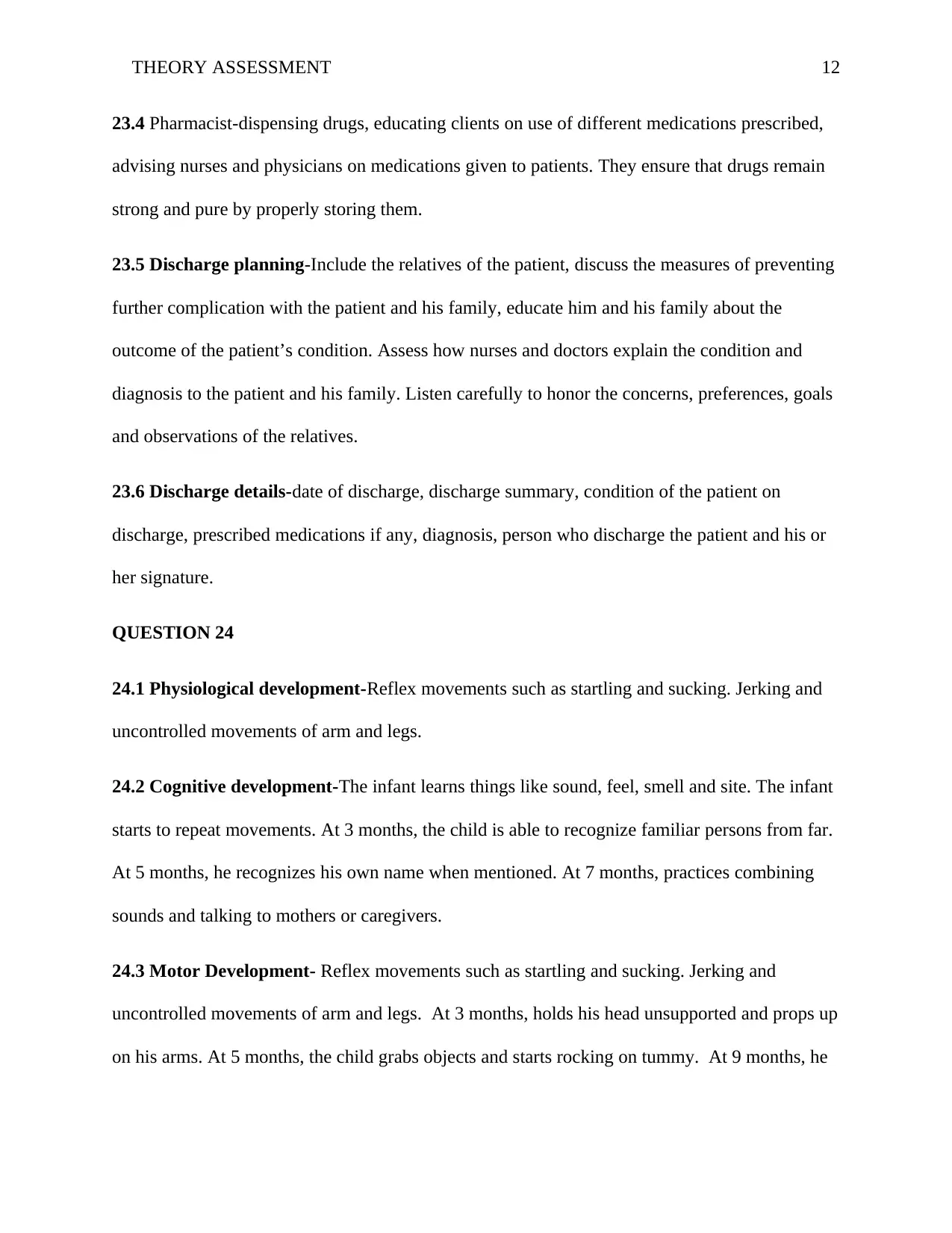
THEORY ASSESSMENT 12
23.4 Pharmacist-dispensing drugs, educating clients on use of different medications prescribed,
advising nurses and physicians on medications given to patients. They ensure that drugs remain
strong and pure by properly storing them.
23.5 Discharge planning-Include the relatives of the patient, discuss the measures of preventing
further complication with the patient and his family, educate him and his family about the
outcome of the patient’s condition. Assess how nurses and doctors explain the condition and
diagnosis to the patient and his family. Listen carefully to honor the concerns, preferences, goals
and observations of the relatives.
23.6 Discharge details-date of discharge, discharge summary, condition of the patient on
discharge, prescribed medications if any, diagnosis, person who discharge the patient and his or
her signature.
QUESTION 24
24.1 Physiological development-Reflex movements such as startling and sucking. Jerking and
uncontrolled movements of arm and legs.
24.2 Cognitive development-The infant learns things like sound, feel, smell and site. The infant
starts to repeat movements. At 3 months, the child is able to recognize familiar persons from far.
At 5 months, he recognizes his own name when mentioned. At 7 months, practices combining
sounds and talking to mothers or caregivers.
24.3 Motor Development- Reflex movements such as startling and sucking. Jerking and
uncontrolled movements of arm and legs. At 3 months, holds his head unsupported and props up
on his arms. At 5 months, the child grabs objects and starts rocking on tummy. At 9 months, he
23.4 Pharmacist-dispensing drugs, educating clients on use of different medications prescribed,
advising nurses and physicians on medications given to patients. They ensure that drugs remain
strong and pure by properly storing them.
23.5 Discharge planning-Include the relatives of the patient, discuss the measures of preventing
further complication with the patient and his family, educate him and his family about the
outcome of the patient’s condition. Assess how nurses and doctors explain the condition and
diagnosis to the patient and his family. Listen carefully to honor the concerns, preferences, goals
and observations of the relatives.
23.6 Discharge details-date of discharge, discharge summary, condition of the patient on
discharge, prescribed medications if any, diagnosis, person who discharge the patient and his or
her signature.
QUESTION 24
24.1 Physiological development-Reflex movements such as startling and sucking. Jerking and
uncontrolled movements of arm and legs.
24.2 Cognitive development-The infant learns things like sound, feel, smell and site. The infant
starts to repeat movements. At 3 months, the child is able to recognize familiar persons from far.
At 5 months, he recognizes his own name when mentioned. At 7 months, practices combining
sounds and talking to mothers or caregivers.
24.3 Motor Development- Reflex movements such as startling and sucking. Jerking and
uncontrolled movements of arm and legs. At 3 months, holds his head unsupported and props up
on his arms. At 5 months, the child grabs objects and starts rocking on tummy. At 9 months, he
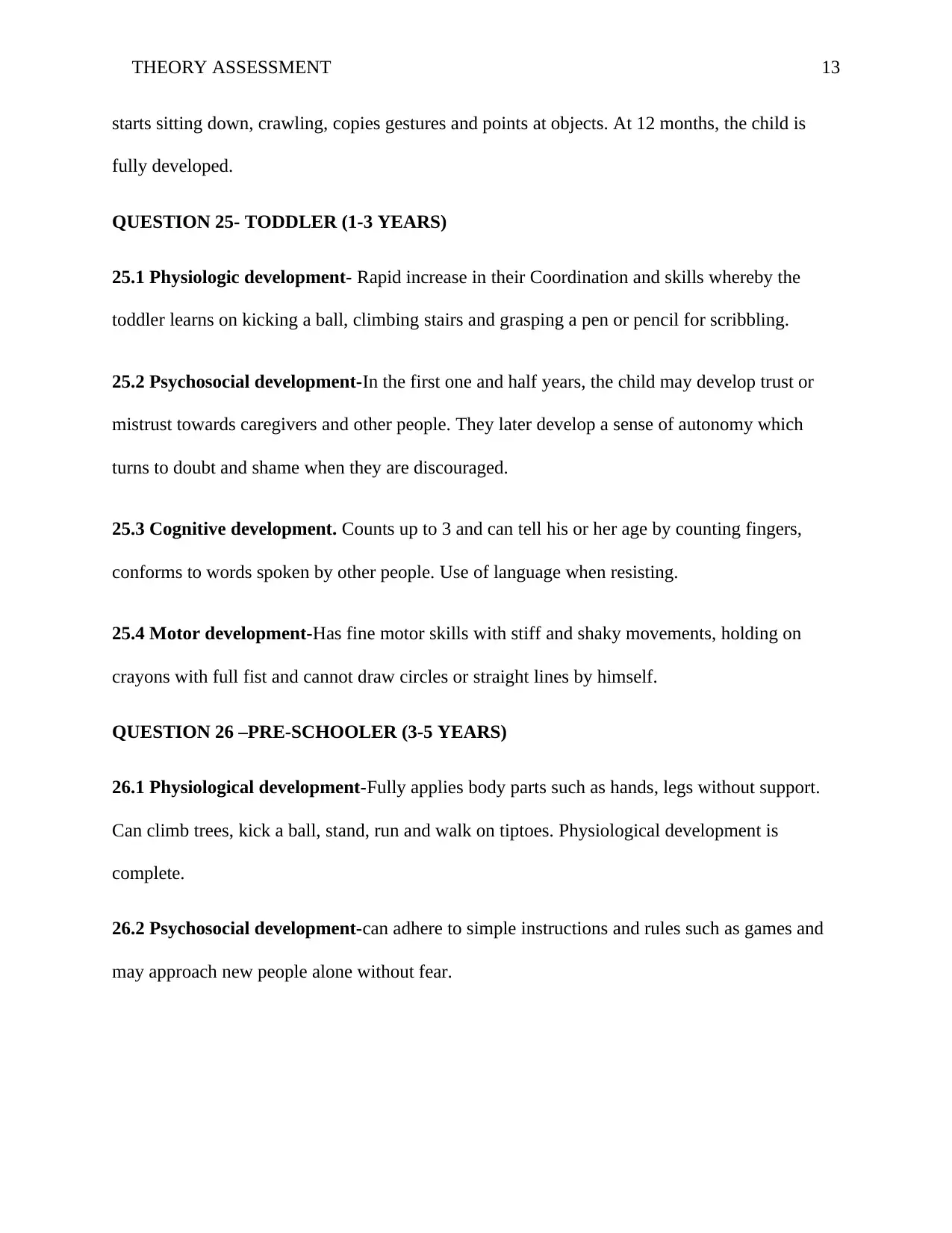
THEORY ASSESSMENT 13
starts sitting down, crawling, copies gestures and points at objects. At 12 months, the child is
fully developed.
QUESTION 25- TODDLER (1-3 YEARS)
25.1 Physiologic development- Rapid increase in their Coordination and skills whereby the
toddler learns on kicking a ball, climbing stairs and grasping a pen or pencil for scribbling.
25.2 Psychosocial development-In the first one and half years, the child may develop trust or
mistrust towards caregivers and other people. They later develop a sense of autonomy which
turns to doubt and shame when they are discouraged.
25.3 Cognitive development. Counts up to 3 and can tell his or her age by counting fingers,
conforms to words spoken by other people. Use of language when resisting.
25.4 Motor development-Has fine motor skills with stiff and shaky movements, holding on
crayons with full fist and cannot draw circles or straight lines by himself.
QUESTION 26 –PRE-SCHOOLER (3-5 YEARS)
26.1 Physiological development-Fully applies body parts such as hands, legs without support.
Can climb trees, kick a ball, stand, run and walk on tiptoes. Physiological development is
complete.
26.2 Psychosocial development-can adhere to simple instructions and rules such as games and
may approach new people alone without fear.
starts sitting down, crawling, copies gestures and points at objects. At 12 months, the child is
fully developed.
QUESTION 25- TODDLER (1-3 YEARS)
25.1 Physiologic development- Rapid increase in their Coordination and skills whereby the
toddler learns on kicking a ball, climbing stairs and grasping a pen or pencil for scribbling.
25.2 Psychosocial development-In the first one and half years, the child may develop trust or
mistrust towards caregivers and other people. They later develop a sense of autonomy which
turns to doubt and shame when they are discouraged.
25.3 Cognitive development. Counts up to 3 and can tell his or her age by counting fingers,
conforms to words spoken by other people. Use of language when resisting.
25.4 Motor development-Has fine motor skills with stiff and shaky movements, holding on
crayons with full fist and cannot draw circles or straight lines by himself.
QUESTION 26 –PRE-SCHOOLER (3-5 YEARS)
26.1 Physiological development-Fully applies body parts such as hands, legs without support.
Can climb trees, kick a ball, stand, run and walk on tiptoes. Physiological development is
complete.
26.2 Psychosocial development-can adhere to simple instructions and rules such as games and
may approach new people alone without fear.
Paraphrase This Document
Need a fresh take? Get an instant paraphrase of this document with our AI Paraphraser
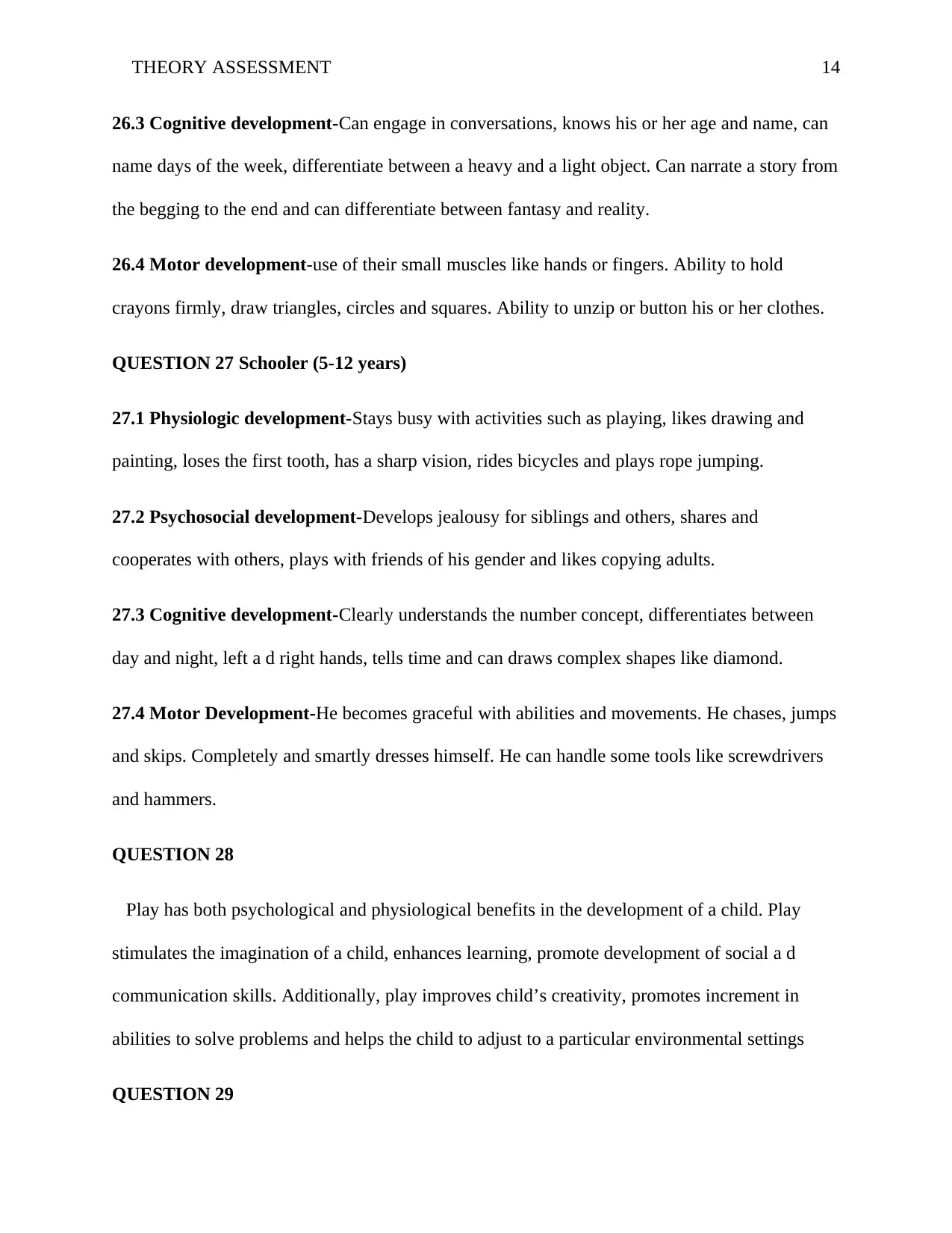
THEORY ASSESSMENT 14
26.3 Cognitive development-Can engage in conversations, knows his or her age and name, can
name days of the week, differentiate between a heavy and a light object. Can narrate a story from
the begging to the end and can differentiate between fantasy and reality.
26.4 Motor development-use of their small muscles like hands or fingers. Ability to hold
crayons firmly, draw triangles, circles and squares. Ability to unzip or button his or her clothes.
QUESTION 27 Schooler (5-12 years)
27.1 Physiologic development-Stays busy with activities such as playing, likes drawing and
painting, loses the first tooth, has a sharp vision, rides bicycles and plays rope jumping.
27.2 Psychosocial development-Develops jealousy for siblings and others, shares and
cooperates with others, plays with friends of his gender and likes copying adults.
27.3 Cognitive development-Clearly understands the number concept, differentiates between
day and night, left a d right hands, tells time and can draws complex shapes like diamond.
27.4 Motor Development-He becomes graceful with abilities and movements. He chases, jumps
and skips. Completely and smartly dresses himself. He can handle some tools like screwdrivers
and hammers.
QUESTION 28
Play has both psychological and physiological benefits in the development of a child. Play
stimulates the imagination of a child, enhances learning, promote development of social a d
communication skills. Additionally, play improves child’s creativity, promotes increment in
abilities to solve problems and helps the child to adjust to a particular environmental settings
QUESTION 29
26.3 Cognitive development-Can engage in conversations, knows his or her age and name, can
name days of the week, differentiate between a heavy and a light object. Can narrate a story from
the begging to the end and can differentiate between fantasy and reality.
26.4 Motor development-use of their small muscles like hands or fingers. Ability to hold
crayons firmly, draw triangles, circles and squares. Ability to unzip or button his or her clothes.
QUESTION 27 Schooler (5-12 years)
27.1 Physiologic development-Stays busy with activities such as playing, likes drawing and
painting, loses the first tooth, has a sharp vision, rides bicycles and plays rope jumping.
27.2 Psychosocial development-Develops jealousy for siblings and others, shares and
cooperates with others, plays with friends of his gender and likes copying adults.
27.3 Cognitive development-Clearly understands the number concept, differentiates between
day and night, left a d right hands, tells time and can draws complex shapes like diamond.
27.4 Motor Development-He becomes graceful with abilities and movements. He chases, jumps
and skips. Completely and smartly dresses himself. He can handle some tools like screwdrivers
and hammers.
QUESTION 28
Play has both psychological and physiological benefits in the development of a child. Play
stimulates the imagination of a child, enhances learning, promote development of social a d
communication skills. Additionally, play improves child’s creativity, promotes increment in
abilities to solve problems and helps the child to adjust to a particular environmental settings
QUESTION 29

THEORY ASSESSMENT 15
Purpose of assessment, reliability, validity, acceptability, fairness, feasibility
QUESTION 30
Developmental stage Reaction to Hospitalisation
30.1 Infant (birth to 18 months) –unable to express verbal communication, irritability,
separation distress, decreased morale for playing, crying a lot, lethargy and tactile
hypersensitivity.
30.2 Toddler (18 months to 3 years) –Views the hospital as a punishment, reduced appetite,
increased cries, irritability, refuses to eat, decreased playing and verbal communication of pain.
30.3 Pre-schooler (3-5 years) –Regression, may perceive the hospital as a punishment,
nightmares, treatment misconceptions, verbalizes pain and aggression.
30.4 Schooler (6-12 years)-Aggression, regression, withdrawal and denial from their favorites
and they may virtualize pain.
QUESTION 31 EFFECTS OF INFERTILITY
31.1 Emotional effects-For women, being a mother is a very important aspects which contribute
to one’s image. One feels frustrated and disappointed by the fact that he or she is not able to have
children. It is also associated with anger and sorrow.
31.2 Control over life –infertility lowers one’s level of self-esteem and confidence hence
compromising life control abilities.
31.3 Social effects-Due to the feelings of depression, sorrow, frustration and anger, one tends to
withdraw from friends and family. He or she feels unaccepted by the society.
Purpose of assessment, reliability, validity, acceptability, fairness, feasibility
QUESTION 30
Developmental stage Reaction to Hospitalisation
30.1 Infant (birth to 18 months) –unable to express verbal communication, irritability,
separation distress, decreased morale for playing, crying a lot, lethargy and tactile
hypersensitivity.
30.2 Toddler (18 months to 3 years) –Views the hospital as a punishment, reduced appetite,
increased cries, irritability, refuses to eat, decreased playing and verbal communication of pain.
30.3 Pre-schooler (3-5 years) –Regression, may perceive the hospital as a punishment,
nightmares, treatment misconceptions, verbalizes pain and aggression.
30.4 Schooler (6-12 years)-Aggression, regression, withdrawal and denial from their favorites
and they may virtualize pain.
QUESTION 31 EFFECTS OF INFERTILITY
31.1 Emotional effects-For women, being a mother is a very important aspects which contribute
to one’s image. One feels frustrated and disappointed by the fact that he or she is not able to have
children. It is also associated with anger and sorrow.
31.2 Control over life –infertility lowers one’s level of self-esteem and confidence hence
compromising life control abilities.
31.3 Social effects-Due to the feelings of depression, sorrow, frustration and anger, one tends to
withdraw from friends and family. He or she feels unaccepted by the society.

THEORY ASSESSMENT 16
31.4 Self-esteem- Infertility in an individual involves typical reactions such as anger, depression,
grief, shock. Frustration and loss of confidence. These reactions lowers one’s level of self-esteem
making him or her feel worthless.
31.5 Relationship- Relationships suffer not only primary ones with a partner but also with
family members and friends who inadvertently lead to pain by proving misguiding advice and
opinions. A couple may avoid socialization especially with fertile friends and they struggle with
the anxiety due to sexual dysfunctions.
QUESTION 32 FAMILY HEALTH CARE NEEDS
Some families may be having children who require specialized health care. Therefore, they will
need the health care professional for guidance.
A couple with infertility issues may need guidance from health care professionals on how to deal
with such a problem and be have a happy life at the same time.
Families have genetically inherited disorders such as asthma, hypertension or sickle cell disease.
They need help from health care professionals for more advice and information on such
problems.
QUESTION 33
33.1 Influence of genetics on human development-Genes are responsible for the characteristics
and traits of an individual. Chromosomes also play an important role in gene formation.
Deoxyribonucleic acid (DNA) and ribonucleic acid (RNA) work together to ensure genetic
31.4 Self-esteem- Infertility in an individual involves typical reactions such as anger, depression,
grief, shock. Frustration and loss of confidence. These reactions lowers one’s level of self-esteem
making him or her feel worthless.
31.5 Relationship- Relationships suffer not only primary ones with a partner but also with
family members and friends who inadvertently lead to pain by proving misguiding advice and
opinions. A couple may avoid socialization especially with fertile friends and they struggle with
the anxiety due to sexual dysfunctions.
QUESTION 32 FAMILY HEALTH CARE NEEDS
Some families may be having children who require specialized health care. Therefore, they will
need the health care professional for guidance.
A couple with infertility issues may need guidance from health care professionals on how to deal
with such a problem and be have a happy life at the same time.
Families have genetically inherited disorders such as asthma, hypertension or sickle cell disease.
They need help from health care professionals for more advice and information on such
problems.
QUESTION 33
33.1 Influence of genetics on human development-Genes are responsible for the characteristics
and traits of an individual. Chromosomes also play an important role in gene formation.
Deoxyribonucleic acid (DNA) and ribonucleic acid (RNA) work together to ensure genetic
Secure Best Marks with AI Grader
Need help grading? Try our AI Grader for instant feedback on your assignments.
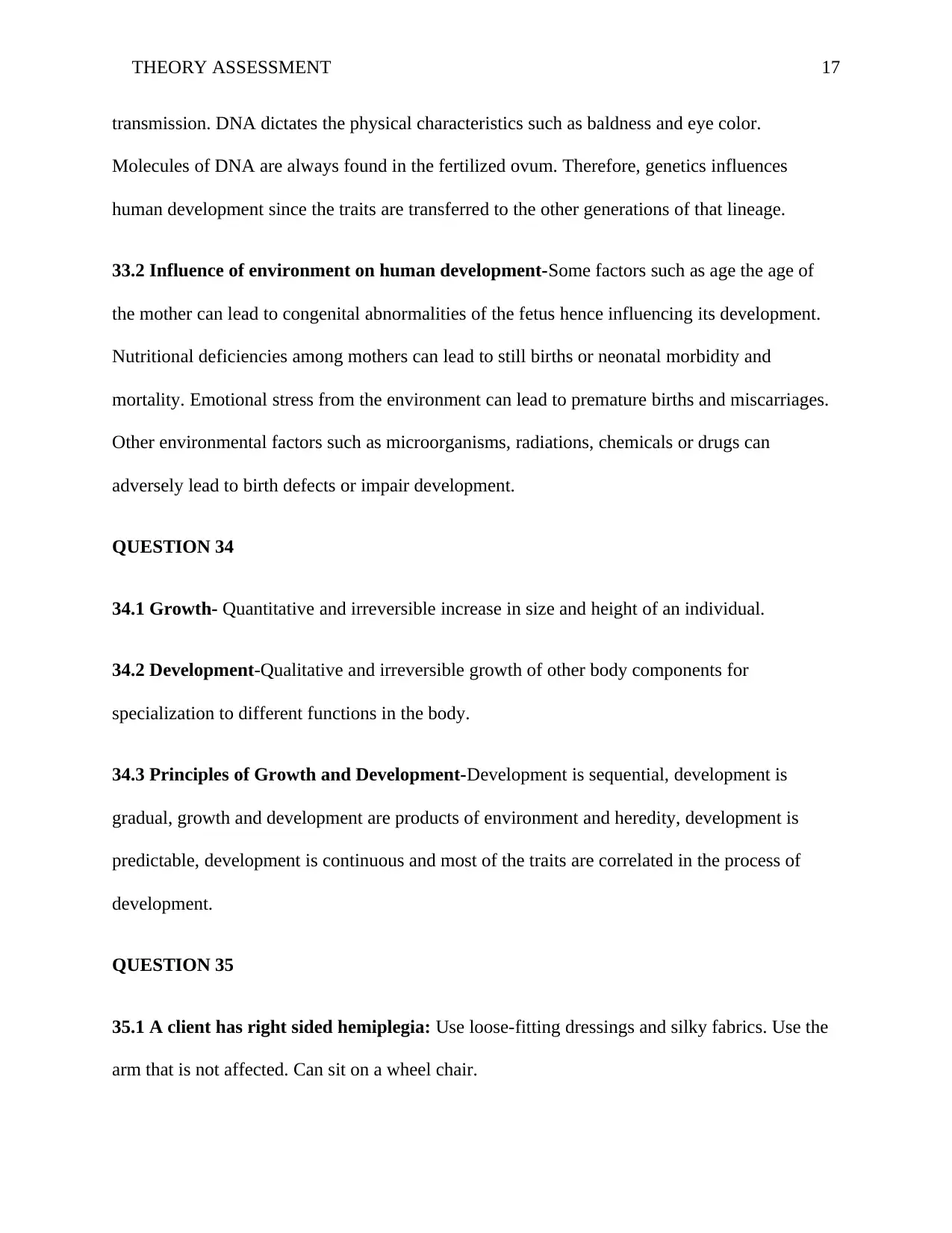
THEORY ASSESSMENT 17
transmission. DNA dictates the physical characteristics such as baldness and eye color.
Molecules of DNA are always found in the fertilized ovum. Therefore, genetics influences
human development since the traits are transferred to the other generations of that lineage.
33.2 Influence of environment on human development-Some factors such as age the age of
the mother can lead to congenital abnormalities of the fetus hence influencing its development.
Nutritional deficiencies among mothers can lead to still births or neonatal morbidity and
mortality. Emotional stress from the environment can lead to premature births and miscarriages.
Other environmental factors such as microorganisms, radiations, chemicals or drugs can
adversely lead to birth defects or impair development.
QUESTION 34
34.1 Growth- Quantitative and irreversible increase in size and height of an individual.
34.2 Development-Qualitative and irreversible growth of other body components for
specialization to different functions in the body.
34.3 Principles of Growth and Development-Development is sequential, development is
gradual, growth and development are products of environment and heredity, development is
predictable, development is continuous and most of the traits are correlated in the process of
development.
QUESTION 35
35.1 A client has right sided hemiplegia: Use loose-fitting dressings and silky fabrics. Use the
arm that is not affected. Can sit on a wheel chair.
transmission. DNA dictates the physical characteristics such as baldness and eye color.
Molecules of DNA are always found in the fertilized ovum. Therefore, genetics influences
human development since the traits are transferred to the other generations of that lineage.
33.2 Influence of environment on human development-Some factors such as age the age of
the mother can lead to congenital abnormalities of the fetus hence influencing its development.
Nutritional deficiencies among mothers can lead to still births or neonatal morbidity and
mortality. Emotional stress from the environment can lead to premature births and miscarriages.
Other environmental factors such as microorganisms, radiations, chemicals or drugs can
adversely lead to birth defects or impair development.
QUESTION 34
34.1 Growth- Quantitative and irreversible increase in size and height of an individual.
34.2 Development-Qualitative and irreversible growth of other body components for
specialization to different functions in the body.
34.3 Principles of Growth and Development-Development is sequential, development is
gradual, growth and development are products of environment and heredity, development is
predictable, development is continuous and most of the traits are correlated in the process of
development.
QUESTION 35
35.1 A client has right sided hemiplegia: Use loose-fitting dressings and silky fabrics. Use the
arm that is not affected. Can sit on a wheel chair.
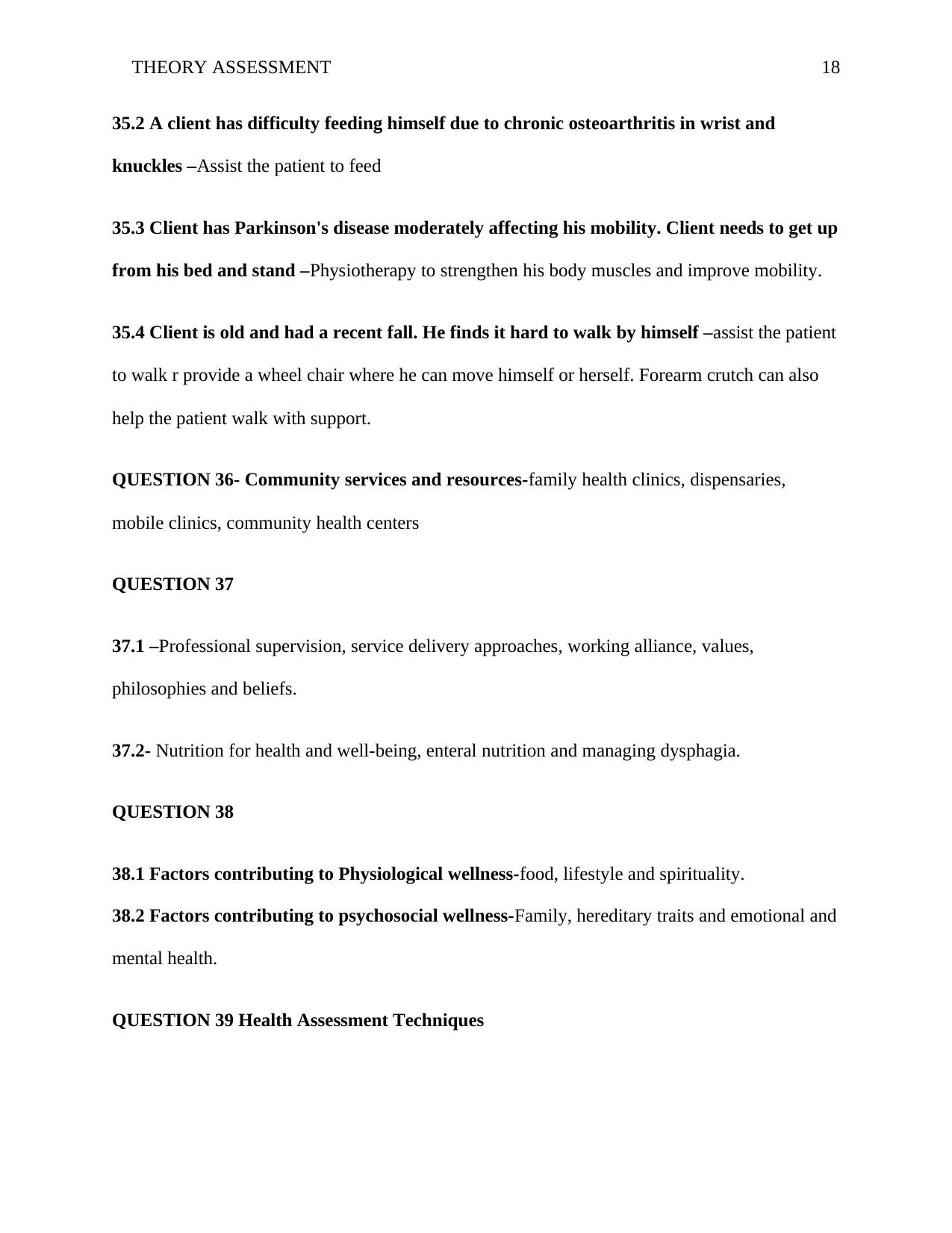
THEORY ASSESSMENT 18
35.2 A client has difficulty feeding himself due to chronic osteoarthritis in wrist and
knuckles –Assist the patient to feed
35.3 Client has Parkinson's disease moderately affecting his mobility. Client needs to get up
from his bed and stand –Physiotherapy to strengthen his body muscles and improve mobility.
35.4 Client is old and had a recent fall. He finds it hard to walk by himself –assist the patient
to walk r provide a wheel chair where he can move himself or herself. Forearm crutch can also
help the patient walk with support.
QUESTION 36- Community services and resources-family health clinics, dispensaries,
mobile clinics, community health centers
QUESTION 37
37.1 –Professional supervision, service delivery approaches, working alliance, values,
philosophies and beliefs.
37.2- Nutrition for health and well-being, enteral nutrition and managing dysphagia.
QUESTION 38
38.1 Factors contributing to Physiological wellness-food, lifestyle and spirituality.
38.2 Factors contributing to psychosocial wellness-Family, hereditary traits and emotional and
mental health.
QUESTION 39 Health Assessment Techniques
35.2 A client has difficulty feeding himself due to chronic osteoarthritis in wrist and
knuckles –Assist the patient to feed
35.3 Client has Parkinson's disease moderately affecting his mobility. Client needs to get up
from his bed and stand –Physiotherapy to strengthen his body muscles and improve mobility.
35.4 Client is old and had a recent fall. He finds it hard to walk by himself –assist the patient
to walk r provide a wheel chair where he can move himself or herself. Forearm crutch can also
help the patient walk with support.
QUESTION 36- Community services and resources-family health clinics, dispensaries,
mobile clinics, community health centers
QUESTION 37
37.1 –Professional supervision, service delivery approaches, working alliance, values,
philosophies and beliefs.
37.2- Nutrition for health and well-being, enteral nutrition and managing dysphagia.
QUESTION 38
38.1 Factors contributing to Physiological wellness-food, lifestyle and spirituality.
38.2 Factors contributing to psychosocial wellness-Family, hereditary traits and emotional and
mental health.
QUESTION 39 Health Assessment Techniques
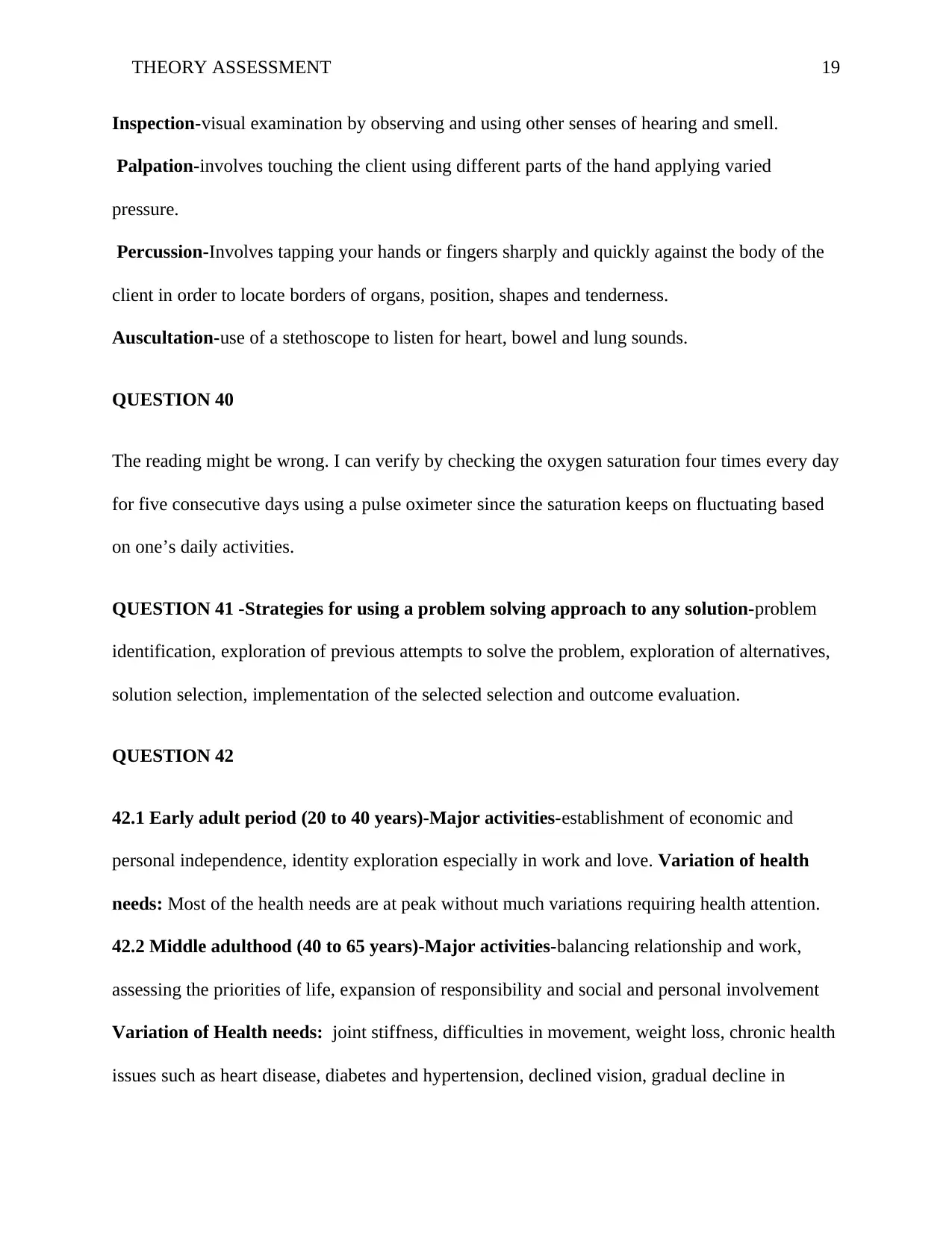
THEORY ASSESSMENT 19
Inspection-visual examination by observing and using other senses of hearing and smell.
Palpation-involves touching the client using different parts of the hand applying varied
pressure.
Percussion-Involves tapping your hands or fingers sharply and quickly against the body of the
client in order to locate borders of organs, position, shapes and tenderness.
Auscultation-use of a stethoscope to listen for heart, bowel and lung sounds.
QUESTION 40
The reading might be wrong. I can verify by checking the oxygen saturation four times every day
for five consecutive days using a pulse oximeter since the saturation keeps on fluctuating based
on one’s daily activities.
QUESTION 41 -Strategies for using a problem solving approach to any solution-problem
identification, exploration of previous attempts to solve the problem, exploration of alternatives,
solution selection, implementation of the selected selection and outcome evaluation.
QUESTION 42
42.1 Early adult period (20 to 40 years)-Major activities-establishment of economic and
personal independence, identity exploration especially in work and love. Variation of health
needs: Most of the health needs are at peak without much variations requiring health attention.
42.2 Middle adulthood (40 to 65 years)-Major activities-balancing relationship and work,
assessing the priorities of life, expansion of responsibility and social and personal involvement
Variation of Health needs: joint stiffness, difficulties in movement, weight loss, chronic health
issues such as heart disease, diabetes and hypertension, declined vision, gradual decline in
Inspection-visual examination by observing and using other senses of hearing and smell.
Palpation-involves touching the client using different parts of the hand applying varied
pressure.
Percussion-Involves tapping your hands or fingers sharply and quickly against the body of the
client in order to locate borders of organs, position, shapes and tenderness.
Auscultation-use of a stethoscope to listen for heart, bowel and lung sounds.
QUESTION 40
The reading might be wrong. I can verify by checking the oxygen saturation four times every day
for five consecutive days using a pulse oximeter since the saturation keeps on fluctuating based
on one’s daily activities.
QUESTION 41 -Strategies for using a problem solving approach to any solution-problem
identification, exploration of previous attempts to solve the problem, exploration of alternatives,
solution selection, implementation of the selected selection and outcome evaluation.
QUESTION 42
42.1 Early adult period (20 to 40 years)-Major activities-establishment of economic and
personal independence, identity exploration especially in work and love. Variation of health
needs: Most of the health needs are at peak without much variations requiring health attention.
42.2 Middle adulthood (40 to 65 years)-Major activities-balancing relationship and work,
assessing the priorities of life, expansion of responsibility and social and personal involvement
Variation of Health needs: joint stiffness, difficulties in movement, weight loss, chronic health
issues such as heart disease, diabetes and hypertension, declined vision, gradual decline in
Paraphrase This Document
Need a fresh take? Get an instant paraphrase of this document with our AI Paraphraser
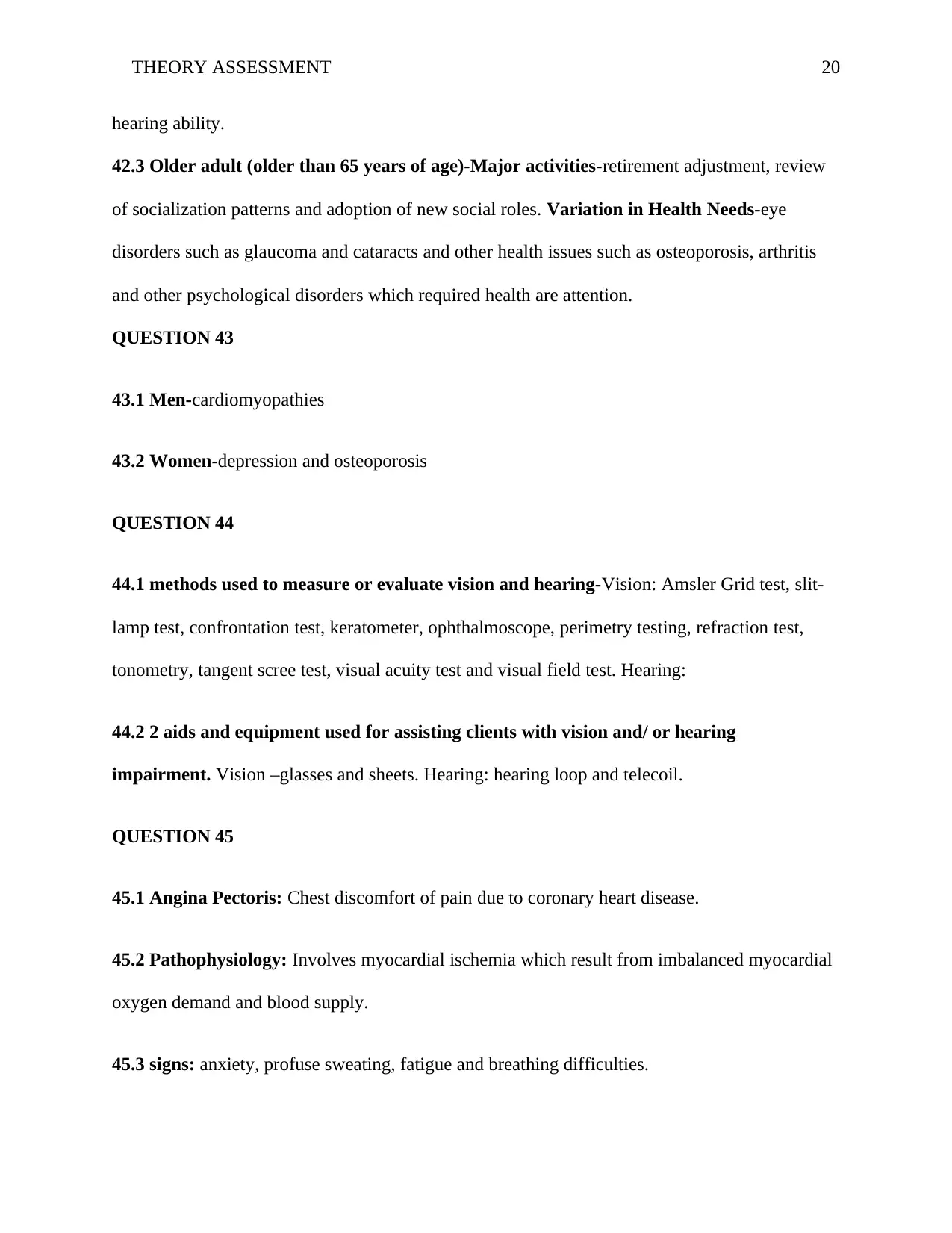
THEORY ASSESSMENT 20
hearing ability.
42.3 Older adult (older than 65 years of age)-Major activities-retirement adjustment, review
of socialization patterns and adoption of new social roles. Variation in Health Needs-eye
disorders such as glaucoma and cataracts and other health issues such as osteoporosis, arthritis
and other psychological disorders which required health are attention.
QUESTION 43
43.1 Men-cardiomyopathies
43.2 Women-depression and osteoporosis
QUESTION 44
44.1 methods used to measure or evaluate vision and hearing-Vision: Amsler Grid test, slit-
lamp test, confrontation test, keratometer, ophthalmoscope, perimetry testing, refraction test,
tonometry, tangent scree test, visual acuity test and visual field test. Hearing:
44.2 2 aids and equipment used for assisting clients with vision and/ or hearing
impairment. Vision –glasses and sheets. Hearing: hearing loop and telecoil.
QUESTION 45
45.1 Angina Pectoris: Chest discomfort of pain due to coronary heart disease.
45.2 Pathophysiology: Involves myocardial ischemia which result from imbalanced myocardial
oxygen demand and blood supply.
45.3 signs: anxiety, profuse sweating, fatigue and breathing difficulties.
hearing ability.
42.3 Older adult (older than 65 years of age)-Major activities-retirement adjustment, review
of socialization patterns and adoption of new social roles. Variation in Health Needs-eye
disorders such as glaucoma and cataracts and other health issues such as osteoporosis, arthritis
and other psychological disorders which required health are attention.
QUESTION 43
43.1 Men-cardiomyopathies
43.2 Women-depression and osteoporosis
QUESTION 44
44.1 methods used to measure or evaluate vision and hearing-Vision: Amsler Grid test, slit-
lamp test, confrontation test, keratometer, ophthalmoscope, perimetry testing, refraction test,
tonometry, tangent scree test, visual acuity test and visual field test. Hearing:
44.2 2 aids and equipment used for assisting clients with vision and/ or hearing
impairment. Vision –glasses and sheets. Hearing: hearing loop and telecoil.
QUESTION 45
45.1 Angina Pectoris: Chest discomfort of pain due to coronary heart disease.
45.2 Pathophysiology: Involves myocardial ischemia which result from imbalanced myocardial
oxygen demand and blood supply.
45.3 signs: anxiety, profuse sweating, fatigue and breathing difficulties.
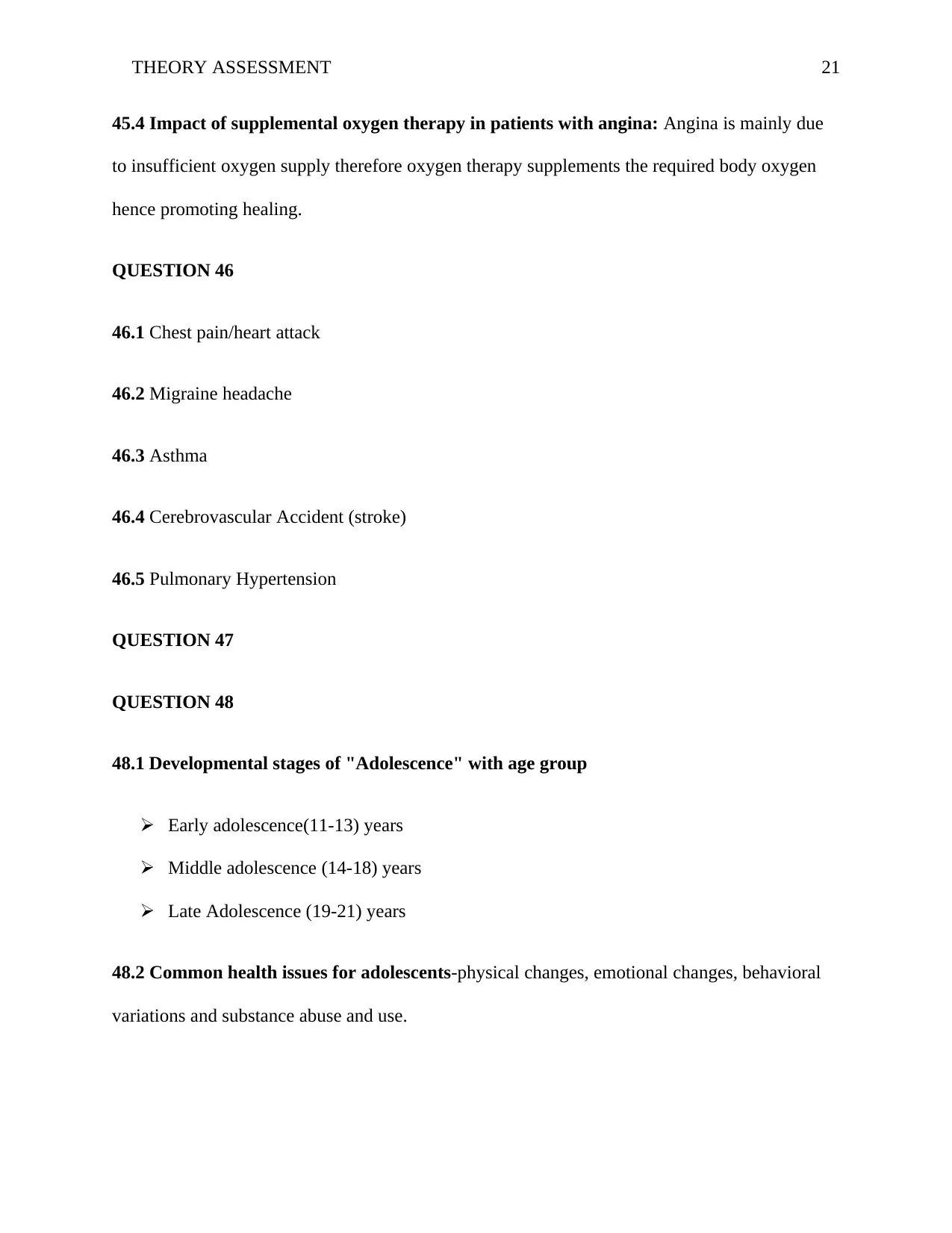
THEORY ASSESSMENT 21
45.4 Impact of supplemental oxygen therapy in patients with angina: Angina is mainly due
to insufficient oxygen supply therefore oxygen therapy supplements the required body oxygen
hence promoting healing.
QUESTION 46
46.1 Chest pain/heart attack
46.2 Migraine headache
46.3 Asthma
46.4 Cerebrovascular Accident (stroke)
46.5 Pulmonary Hypertension
QUESTION 47
QUESTION 48
48.1 Developmental stages of "Adolescence" with age group
Early adolescence(11-13) years
Middle adolescence (14-18) years
Late Adolescence (19-21) years
48.2 Common health issues for adolescents-physical changes, emotional changes, behavioral
variations and substance abuse and use.
45.4 Impact of supplemental oxygen therapy in patients with angina: Angina is mainly due
to insufficient oxygen supply therefore oxygen therapy supplements the required body oxygen
hence promoting healing.
QUESTION 46
46.1 Chest pain/heart attack
46.2 Migraine headache
46.3 Asthma
46.4 Cerebrovascular Accident (stroke)
46.5 Pulmonary Hypertension
QUESTION 47
QUESTION 48
48.1 Developmental stages of "Adolescence" with age group
Early adolescence(11-13) years
Middle adolescence (14-18) years
Late Adolescence (19-21) years
48.2 Common health issues for adolescents-physical changes, emotional changes, behavioral
variations and substance abuse and use.
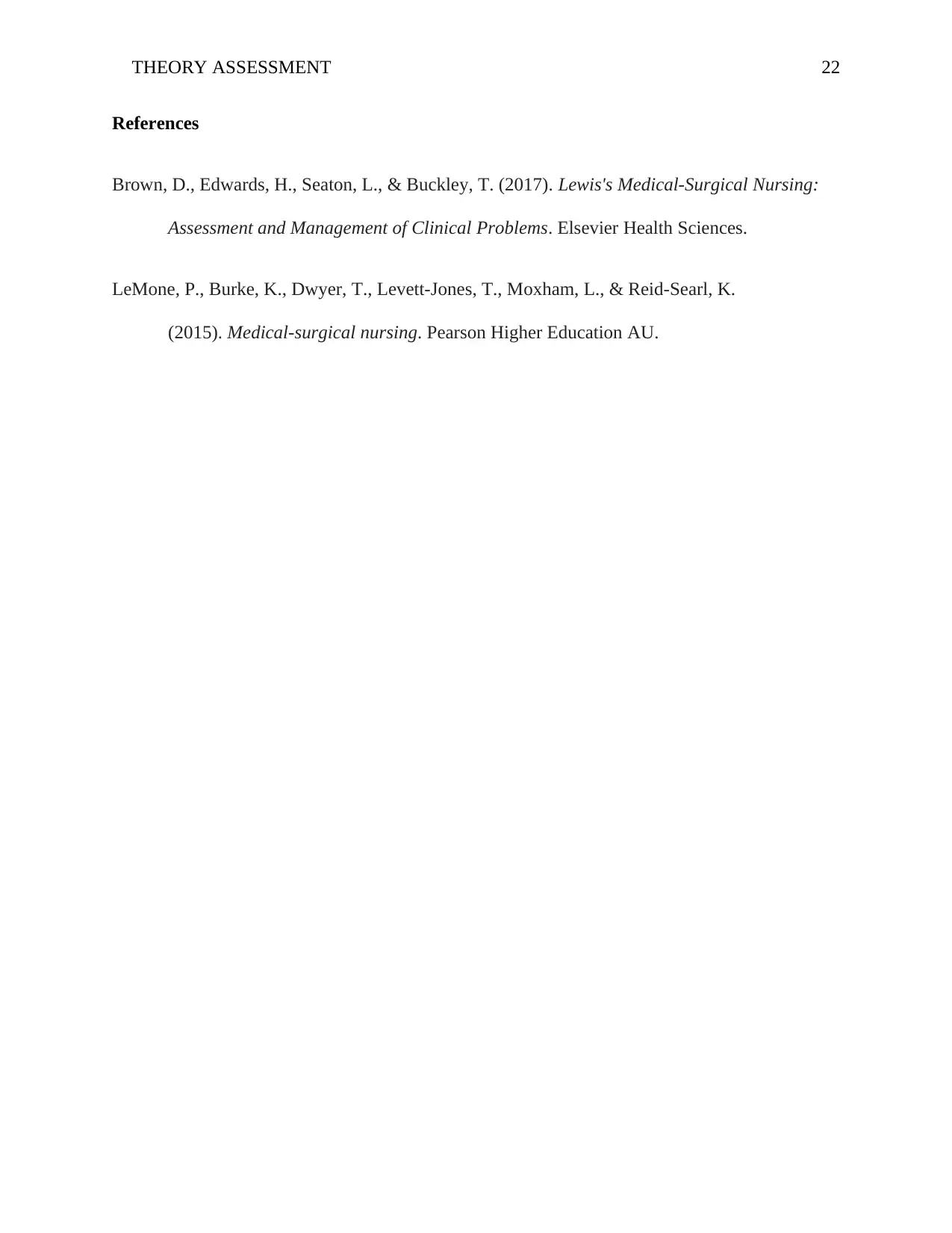
THEORY ASSESSMENT 22
References
Brown, D., Edwards, H., Seaton, L., & Buckley, T. (2017). Lewis's Medical-Surgical Nursing:
Assessment and Management of Clinical Problems. Elsevier Health Sciences.
LeMone, P., Burke, K., Dwyer, T., Levett-Jones, T., Moxham, L., & Reid-Searl, K.
(2015). Medical-surgical nursing. Pearson Higher Education AU.
References
Brown, D., Edwards, H., Seaton, L., & Buckley, T. (2017). Lewis's Medical-Surgical Nursing:
Assessment and Management of Clinical Problems. Elsevier Health Sciences.
LeMone, P., Burke, K., Dwyer, T., Levett-Jones, T., Moxham, L., & Reid-Searl, K.
(2015). Medical-surgical nursing. Pearson Higher Education AU.
1 out of 22
Your All-in-One AI-Powered Toolkit for Academic Success.
+13062052269
info@desklib.com
Available 24*7 on WhatsApp / Email
![[object Object]](/_next/static/media/star-bottom.7253800d.svg)
Unlock your academic potential
© 2024 | Zucol Services PVT LTD | All rights reserved.
